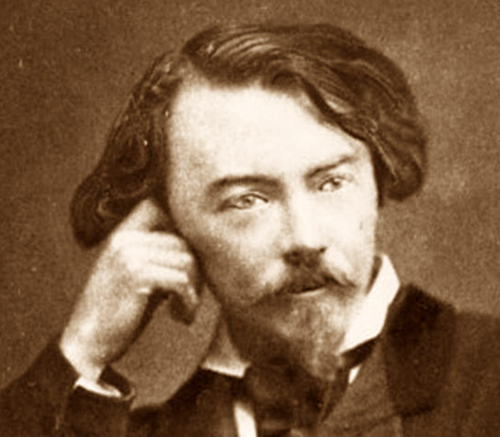
Luc-Olivier d’Algange:
Notes sur Villiers de L’Isle-Adam
Pour quelques écrivains qui sont aussi poètes et métaphysiciens, l'Œuvre, au sens alchimique, coïncide avec la création littéraire. Le dédain où divers « praticiens » tiennent la littérature est la preuve de leur profonde méconnaissance des vertus transfiguratrices et initiatiques du langage.
Le langage, selon qui en use, peut être la chose la plus banale, la plus bassement profanée, mais aussi la plus resplendissante des expériences humaines. Or, il est une constante en philosophie hermétique: l'aboutissement ultime, glorieux, a pour origine la matière la plus commune qui soit. Telle est aussi la parole humaine, sans cesse dispensée pour ne rien dire, voire pour ne rien entendre (et nous ne parlons souvent que pour n'être pas mis en demeure d'écouter notre semblable) mais quelquefois saisie d'une fureur sacrée, d'une luminosité imprévue qui nous gagne et suscite en nous cet enthousiasme, cette allégresse qui nous annoncent que soudain notre existence va trouver son sens, c'est-à-dire, son essor. De tout ce qui nous importe vraiment, il n'est rien, dans le tréfonds de nos âmes et aux confins de notre conscience dont la destinée ne fût essentiellement liée à l'envol, à l'élévation, à la légèreté et d'une façon ou d'une autre, au Ciel. La souveraineté de l'Esprit est avant tout la reconnaissance en nous d'un intarissable désir de nous joindre au Souffle, à cette prodigieuse liberté qui, croyons-nous, règne dans les Hauteurs. Or, de ces Hauteurs, dont nous hante la nostalgie, palpite le reflet dans les abysses même du langage: images, icônes, blasons dont naquirent tous les mots et toutes les phrases et dont nous retrouvons les figures simples dans les œuvres les plus savantes et les plus nobles; l'extrême science ne cessant de sertir plus somptueusement ces pierres primordiales, sans âge, que notre enfance aimait déjà et dont nous emporterons avec nous, dans la mort, l'ultime et versicolore consolation.
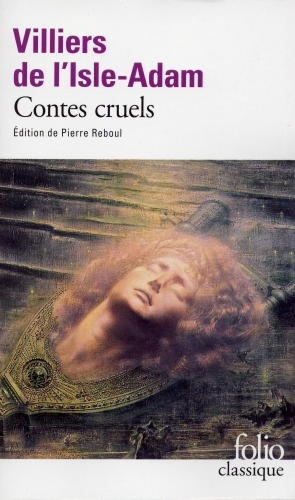 De ces nostalgies et de ces pressentiments l'œuvre de Villiers de l'Isle-Adam magnifiquement témoigne, la création littéraire étant pour lui identique à l'Œuvre alchimique par laquelle l'individu se délivre à la fois du monde et de lui-même. Toutefois, l'état général du monde étant à la déchéance et à la trahison, cette délivrance ne pouvant plus s'accomplir que par exception, elle sera désormais limitée à cette élite ultime dont la sagesse implique une lucide révolte contre le monde moderne et « l'hypnotisme du Progrès » qui, ainsi que nous le montrent L'Affichage céleste et La Machine à analyser le dernier soupir, sont allés jusqu'à profaner le Ciel et la Mort !
De ces nostalgies et de ces pressentiments l'œuvre de Villiers de l'Isle-Adam magnifiquement témoigne, la création littéraire étant pour lui identique à l'Œuvre alchimique par laquelle l'individu se délivre à la fois du monde et de lui-même. Toutefois, l'état général du monde étant à la déchéance et à la trahison, cette délivrance ne pouvant plus s'accomplir que par exception, elle sera désormais limitée à cette élite ultime dont la sagesse implique une lucide révolte contre le monde moderne et « l'hypnotisme du Progrès » qui, ainsi que nous le montrent L'Affichage céleste et La Machine à analyser le dernier soupir, sont allés jusqu'à profaner le Ciel et la Mort !
Dès lors, Villiers va fondre en l'exigence de l'Auteur les diverses possibilités créatrices du Mage et du Poète, de celui qui maîtrise la part invisible du monde et de celui qui la réalise. « Ta vérité sera ce que tu l'auras conçue: son essence n'est pas infinie, comme toi ! Ose donc l'enfanter la plus radieuse, c'est-à-dire la choisir telle... car elle aura déjà précédé de ton être tes pensées, devant s'y appeler sous cette forme où tu l'y reconnaîtras! Conclus enfin qu'il est difficile de devenir un Dieu,- et passe outre: car cette pensée même si tu t'y arrêtes devient inférieure: elle contient une hésitation stérile. »(1) Cet appel, que Maître Janus adresse à Axël, résume assez bien ce sens de la grandeur, cette magnanimité intérieure que la Délivrance désirée exige de l'Adepte. Choisir de toutes les illusions la plus grande et la plus belle, tel sera le dessein de l'Auteur conscient de ses privilèges. « L'Initiation, écrit Raymond Abellio, est l'éveil de la conscience à sa propre conscience de soi transcendantale. Elle est intériorisation des ténèbres et transmutation radicale de celles-ci en même temps que de l'être tout entier. » (2) Cette citation d'Abellio éclaire non seulement le propos de Villiers concernant l'essence de l'homme, elle donne aussi une idée des diverses épreuves à travers lesquelles Axël d'Aüersperg devra passer, épreuves de l'enténèbrement par l'or et d'obscuration par la passion, avant d'atteindre à l'infini qu'il porte en lui, de toute éternité, et précédant de son être, ses pensées.
L'Auteur d'Axël ne se contente pas d'un quelconque « travail du texte » pas davantage qu'il n'envisage de réduire sa fonction à distraire son lecteur, et son éventuel spectateur. Le dessein de l'œuvre est magnifique,- au sens que Saint-Pol-Roux donnera à ce mot dans un mouvement qui se voudra « symboliste comme Dante » et s'intitulera le Magnificisme. L'Auteur est le « prophète de la grandeur »" et son œuvre est l'autobiographie spirituelle de cette quête de l'immensité et de la transparence. Aux journalistes qui l'interrogent sur Axël d'Aüersperg, Villiers de L'Isle-Adam donne la seule réponse ingénue et magnifique: « Vous y verrez la promenade à travers toute existence, toute apparence, toute pensée, du héros accompli de corps et d'âme, en qui j'ai mis toutes mes complaisances. Et je veux que telle soit la conclusion qui s'impose à ceux qui sortiront de cette lecture: Illusion pour illusion, nous gardons celle de Dieu, qui seule donne à ses éternels éblouis la lumière et la paix. »(3)
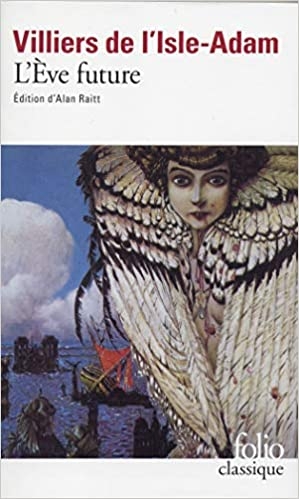 A la différence d'autres œuvres qui ne sont « initiatiques » que par analogie lointaine, si ce n'est par abus de langage, un usage ornemental des symboles religieux ayant abusé les exégètes, l'œuvre de Villiers mérite d'autant mieux d'être dite initiatique, et initiatrice, qu'elle se définit telle, et de façon fort guerroyante, à l'encontre du monde moderne, profane et bourgeois. Dans l'introduction à son livre Initiation, rites, sociétés secrètes, Mircéa Eliade définit en effet le monde moderne comme étant précisément un monde qui se caractérise par son absence d'initiation: « D'une importance capitale dans les sociétés traditionnelles, l'initiation est pratiquement inexistante dans la société occidentale de nos jours. Certes, les différentes confessions chrétiennes conservent, dans une mesure variable, des traces d'un Mystère initiatique. Le baptême est essentiellement un rite initiatique; le sacerdoce comporte une initiation. Mais il ne faut pas oublier que le christianisme n'a justement triomphé et n'est devenu une religion universelle que parce qu'il s'est détaché du climat des Mystères gréco-orientaux et s'est proclamé une religion du salut accessible à tous. D'autre part, a-t-on encore le droit d'appeler chrétien le monde moderne en sa totalité ? S'il existe un homme moderne, c'est bien dans la mesure où il refuse de se reconnaître dans l'anthropologie chrétienne. L'originalité de l'homme moderne, sa nouveauté par rapport aux sociétés traditionnelles, c'est précisément sa volonté de se considérer un être uniquement historique, son désir de vivre dans un cosmos radicalement désacralisé. » (4) Ce pourquoi, dans l'œuvre de Villiers, l'exigence du cheminement initiatique se fonde sur une préalable réfutation de toutes les valeurs du monde moderne, réfutation d'autant plus héroïque que ces valeurs sont dominantes et fermement résolues, semble-t-il, à ne rien laisser survivre qui ne leur fût docile. En témoigne ce propos, rapporté par Victor Emile Michelet: « Axël n'a pas pour théâtre l'espace céleste. C'est un aigle prisonnier dans une cave, mais il s'y démène avec une telle furie, un tel fracas d'aileron que le bruit percera les épaisses voûtes et l'on entendra au dehors les clameurs de l'aigle blessé. »(5)
A la différence d'autres œuvres qui ne sont « initiatiques » que par analogie lointaine, si ce n'est par abus de langage, un usage ornemental des symboles religieux ayant abusé les exégètes, l'œuvre de Villiers mérite d'autant mieux d'être dite initiatique, et initiatrice, qu'elle se définit telle, et de façon fort guerroyante, à l'encontre du monde moderne, profane et bourgeois. Dans l'introduction à son livre Initiation, rites, sociétés secrètes, Mircéa Eliade définit en effet le monde moderne comme étant précisément un monde qui se caractérise par son absence d'initiation: « D'une importance capitale dans les sociétés traditionnelles, l'initiation est pratiquement inexistante dans la société occidentale de nos jours. Certes, les différentes confessions chrétiennes conservent, dans une mesure variable, des traces d'un Mystère initiatique. Le baptême est essentiellement un rite initiatique; le sacerdoce comporte une initiation. Mais il ne faut pas oublier que le christianisme n'a justement triomphé et n'est devenu une religion universelle que parce qu'il s'est détaché du climat des Mystères gréco-orientaux et s'est proclamé une religion du salut accessible à tous. D'autre part, a-t-on encore le droit d'appeler chrétien le monde moderne en sa totalité ? S'il existe un homme moderne, c'est bien dans la mesure où il refuse de se reconnaître dans l'anthropologie chrétienne. L'originalité de l'homme moderne, sa nouveauté par rapport aux sociétés traditionnelles, c'est précisément sa volonté de se considérer un être uniquement historique, son désir de vivre dans un cosmos radicalement désacralisé. » (4) Ce pourquoi, dans l'œuvre de Villiers, l'exigence du cheminement initiatique se fonde sur une préalable réfutation de toutes les valeurs du monde moderne, réfutation d'autant plus héroïque que ces valeurs sont dominantes et fermement résolues, semble-t-il, à ne rien laisser survivre qui ne leur fût docile. En témoigne ce propos, rapporté par Victor Emile Michelet: « Axël n'a pas pour théâtre l'espace céleste. C'est un aigle prisonnier dans une cave, mais il s'y démène avec une telle furie, un tel fracas d'aileron que le bruit percera les épaisses voûtes et l'on entendra au dehors les clameurs de l'aigle blessé. »(5)
Encore que l'on puisse y discerner une analogie avec la caverne platonicienne, la « cave » n'est ici rien d'autre que la modernité que Villiers ne prétend nullement pouvoir frapper d'inconsistance par les seules vertus de sa révolte ou de sa sagesse. La souveraineté de la connaissance, la gnose la plus pure ne peuvent à elles seules effacer la déchéance où se trouve le monde. Dans l'oubli des principes divins, l'humanité est condamnée à une vie qui est en-deçà de la vie. Elle subsiste, ayant rompu avec les messages des Hauteurs, dans cet inframonde figuré par les caves, alvéoles souterraines où, par définition, la contemplation des vastitudes célestes est impossible. Ce pourquoi l'Initiation débute par la révolte, la blessure, le cri, ces instances du monde tragique. Avant même d'entrer dans le cycle des épreuves, Axël débute son initiation par un meurtre, comme si l'Age Noir, ayant étendu son règne sur toute chose, on ne pouvait, sans violence, se détacher de l'ordre profane. Le Commandeur qu'Axël exécute à la fin de la troisième partie, Le Monde tragique, peut apparaître comme une figure inverse du Don Juan de Mozart où le meurtre du Commandeur est une transgression de la morale chrétienne. Alors que Don Juan défie le sacré, Axël, lui, défie les normes profanes. De ce fait, Axël n'est point englouti dans les enfers comme Don Juan, pas davantage qu'il ne semble éprouver le moindre repentir de son geste. Toutefois si l'exécution du Commandeur n'apparaît pas comme une faute morale (le Commandeur, au demeurant, s'étant rendu assez odieux dans les scènes précédentes pour ne pas apitoyer davantage le spectateur) elle s'inscrit dans le destin d'Axël comme une sorte d'erreur magique. Désormais le meurtrier, en vertu d'une mystérieuse loi de sympathie, va hériter des caractères de sa victime, et jusqu'à un certain point, devenir semblable à elle.
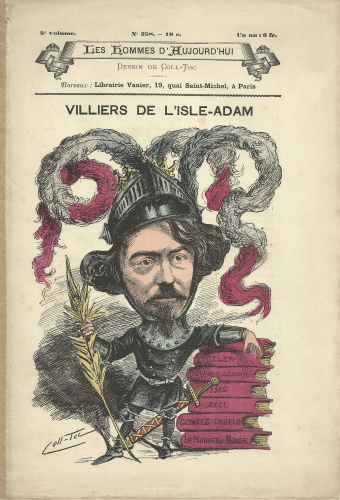
Par cet « Œuvre-au-noir » débute le processus initiatique: « Te voici donc mûr pour l'Epreuve suprême. La vapeur du Sang versé pour de l'Or vient de t'amoindrir l'être: ses fatals effluves t'enveloppent, te pénètrent le cœur... Héritier des instincts de l'homme que tu as tué, les vieilles soifs de volupté, de puissance, d'orgueil, respirées et résorbées dans ton organisme, s'allument au plus rouge de tes veines. Or, descendu des seuils sacrés, l'ancien mortel va ressusciter dans les méconnaissables yeux de l'initié coupable ! C'est bien l'heure.- Elle aussi va venir, celle qui renonçait à l'idéal divin pour le secret de l'Or, comme tu vas renoncer tout à l'heure, à tes sublimes finalités, pour ce méprisable secret. Voici donc en présence la dualité finale des deux races, élues par moi, du fond des âges, pour que soit vaincue, par la simple et virginale humanité, la double illusion de l'Or et de l'Amour,- c'est-à-dire pour que soit fondée, en un point du devenir, la vertu d'un Signe nouveau.»(6)
La vertu du Signe nouveau est déïfiante, elle s'écarte de la banale voie du mérite: tel est le principe des idées philosophiques que développe Maître Janus dans la troisième partie d'Axël, qui s'intitule Le Monde Occulte. Que les écrits hermétistes du XIXème siècle fussent le support de ces hautes spéculations (Pierre Mariel cite un certain nombre de passages qui sont presque mot pour mot, empruntés au Dogme et rituel de la Haute-Magie, d'Eliphas Levi), cela n'empêche nullement Villiers de rejoindre des considérations qui appartiennent véritablement à la Tradition universelle, au sens guénonien, et ne doivent plus rien d'essentiel à tel ou tel auteur particulier de son siècle.
De même que Villiers, d'après Eugène Lefébure, regarde l'œuvre de Hegel comme « une explication incomplète de l'Evangile »(7) (et, par voie de conséquence en fait un usage qui s'écarte pour le moins de celui qu'en firent Marx ou Engels), sa lecture des hermétistes et des occultistes de son temps s'apparente, de la même façon, à une tentative de reconquérir, ou mieux encore, de reconstruire de l'intérieur, avec les matériaux dont il dispose, cette théosophie immémoriale qui est le cœur secret de la théologie chrétienne et dont tous les accès ont été obstrués, y compris par les dévots eux-mêmes. Hegel, la philosophie idéaliste de Fichte ou de Schopenhauer, l'hermétisme, le catholicisme sont ainsi pour Villiers autant de moyens de reconquérir la Science Sacrée, la Gnose, la Tradition dont la modernité est l'Ennemie. En cela Villiers partage l'intention affirmée de Saint-Yves d'Alveydre ou de Fabre d'Olivet mais il n'en est point l'épigone.
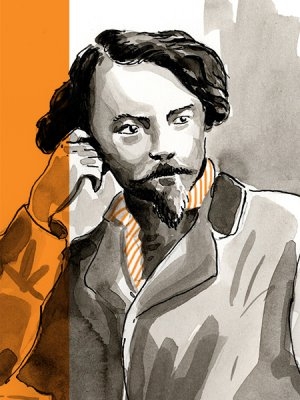 « Epouse en toi la destruction de la Nature; résiste à ses aimants mortels. Sois la privation ! Renonce ! Délivre-toi. Sois ta propre victime ! Consacre-toi sur les brasiers d'amour de la Science auguste pour y mourir, en ascète de la mort des phénix. Ainsi réfléchissant l'essentielle valeur de tes jours sur la Loi, tous leurs moments pénétrés de sa réfraction, participeront de ta pérennité. Ainsi tu annuleras en toi, autour de toi, toute limite ! Et oublieux à jamais de ce qui fut l'illusion de toi-même, ayant conquis, libre enfin, l'idée de ton être, tu deviendras dans l'Intemporel, esprit purifié, distincte essence en l'esprit absolu,- le consort même de ce que tu appelles Déïté. »(8)
« Epouse en toi la destruction de la Nature; résiste à ses aimants mortels. Sois la privation ! Renonce ! Délivre-toi. Sois ta propre victime ! Consacre-toi sur les brasiers d'amour de la Science auguste pour y mourir, en ascète de la mort des phénix. Ainsi réfléchissant l'essentielle valeur de tes jours sur la Loi, tous leurs moments pénétrés de sa réfraction, participeront de ta pérennité. Ainsi tu annuleras en toi, autour de toi, toute limite ! Et oublieux à jamais de ce qui fut l'illusion de toi-même, ayant conquis, libre enfin, l'idée de ton être, tu deviendras dans l'Intemporel, esprit purifié, distincte essence en l'esprit absolu,- le consort même de ce que tu appelles Déïté. »(8)
En ce passage capital d'Axël, où nous pouvons reconnaître ce que Henry Corbin a nommé une « métaphysique de l'être à l'impératif », nous retrouvons cette tradition théosophique, ou gnostique, dont nous écartent à la fois la croyance littéraliste et l'agnosticisme. Dans L'Imagination créatrice dans le soufisme d'Ibn'Arabi, Henry Corbin précise ainsi la différence fondamentale qui existe entre une métaphysique de l'Etre, qui débouche sur une véritable initiation, c'est-à-dire une « renaissance immortalisant »" (la « mort des Phénix ») et d'autres voies de connaissance, profanes ou religieuses: « Le non-gnostique, le croyant dogmatique, ignore et ne peut qu'être scandalisé si on le lui suggère, que la louange qu'il offre à celui en qui il croit est une louange qui s'adresse à soi-même. Cela justement parce que n'étant pas un gnostique, il ignore le processus et le sens de cette création à l'œuvre dans la croyance, et reste inconscient de ce qui en fait la vérité. Aussi érige-t-il sa croyance en un dogme absolu, alors qu'elle est nécessairement limitée et conditionnée. D'où ces impitoyables luttes entre croyances qui rivalisent, se rejettent, se réfutent les unes les autres. Au fond, juge Ibn'Arabi, la croyance de ces croyants n'a d'autre nature que celle d'une opinion, et ils n'ont pas conscience de ce qu'implique cette parole divine: je me conforme à l'opinion que mon fidèle à de moi. » (9)
Etre initié, c'est reconquérir l'Etre et comprendre que le Soi, qui demeure, est la seule réalité. Le monde que les positivistes réputent réel n'est que représentation, illusion, ce que la tradition hindoue nomme « le voile de May »". La Déïté est le Soi, seule réalité qui ne passe point. La connaissance de la réalité divine, seule réalité, exige donc de la part de l'Initié qu'il reconnaisse en lui sa propre nature divine, idée centrale de la philosophie néoplatonicienne. Dans les Ennéades de Plotin il est dit que « Jamais un œil ne verrait le soleil sans être semblable au soleil ni une âme ne verrait le Beau sans être belle »(10). Hors cette concordance essentielle, l'initiation s'avère impossible. En témoigne également le Corpus Herméticum: « Si tu ne te rends pas égal à Dieu, tu ne peux comprendre Dieu ». (11)
Ces quelques citations suffisent à montrer que l'idée de l'Initiation, en tant que connaissance déïfiante, loin d'être une fantaisie ou une outrance d'auteur, s'inscrit dans une tradition gnostique, dont les hermétistes du XIXème siècle sont, pour une part les héritiers, mais souvent les héritiers confus. Dans l'œuvre de Villiers, l'Initiation, loin de se perdre dans une profusion de rites et de symboles disparates, retrouve la pureté de son dessein. L'initiation, l'étymologie l'indique, suppose l'idée de renaissance. Or, pour renaître, il faut mourir. Telle est précisément la leçon d'Axël. La mort de Sara et d'Axël n'est pas une défaite mais, l'ordre du monde étant ce qu'il est, la plus belle des victoires possibles. Leur mort est la mort des Phénix, c'est-à-dire, la « mort de la mort », qui précède la renaissance immortalisante. Cette initiation peut-être dite surhumaniste en ce qu'elle implique, de la part des initiés, de vaincre en eux toute appartenance à l'espèce humaine et au monde, qui est l'illusion la plus commune de l'espèce. Tout en s'inspirant de ce qui chez les occultistes est la trace d'une tradition immémoriale, Villiers se défait des aspects folkloriques, exotiques ou ornementaux des livres d'Eliphas Levi ou de Papus. L'Idée, pour Villiers, prime tous les rites. L'acte magique, par excellence, c'est d'écrire, et ensuite, l'œuvre accomplie, de se taire. La Haute-Magie, pour Villiers, comme pour Mallarmé, se révèle dans l'abysse-miroir qui unit et sépare la Parole et le Silence.
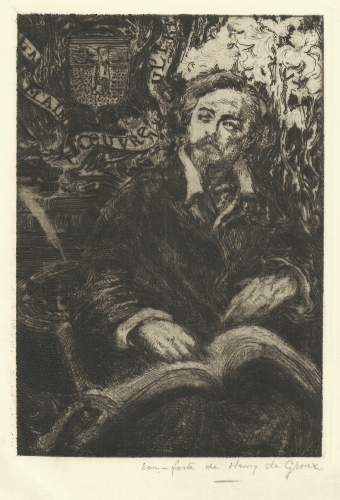
« Sache une fois pour toutes qu'il n'est d'autre univers pour toi que la conception même qui s'en réfléchit au fond de tes pensées;- car tu ne peux le voir pleinement, ni le connaître, en distinguer même un seul point tel que ce mystérieux point doit être en sa réalité. Si par impossible, tu pouvais, un moment, embrasser l'omnivision du monde, ce serait encore une illusion l'instant d'après, puisque l'univers change,- comme tu changes toi-même,- à chaque battement de tes veines, et qu'ainsi son Apparaître, quel qu'il puisse être, n'est en principe que fictif, mobile, illusoire, insaisissable. » (12). Illusion dans l'illusion, ténèbres à l'intérieur des ténèbres, tel est l'Apparaître. Sans doute faut-il désespérer de tout pour être enfin un Délivré. Mais cette désespérance n'est en aucune façon un consentement à la passivité ou à la résignation; c'est une désespérance ardente, impérieuse, qui rejoint les plus belles inspirations d'Angélus Silésius: « Vois, ce monde est passager... Que dis-je ? Il ne passe pas, ce n'est que l'obscurité que Dieu brise en lui. » (13). Or, de cet Apparaître fictif et trompeur, l'homme, en tant qu'il appartient à l'espèce humaine, est partie intégrante: « Où ta limite en lui, s'interroge Villiers, où la tienne en toi ? ... Il s'agit donc de t'en isoler, de t'en affranchir, de vaincre en toi ses fictions, ses mobilités, ses illusions, son caractère ! Telle est la vérité selon l'absolu que tu peux pressentir, car la Vérité n'est elle-même qu'une indécise conception de l'espèce où tu passes et qui prête à la Totalité les formes de son esprit. Si tu veux la posséder, Crée la ! Comme tout le reste ! » (14) « Ce qu'est Dieu, dit encore Angélus Silésius, on ne le sait: Il est ce que moi, toi, et toute créature nous n'apprenons jamais avant d'être devenu ce qu'Il est. »(15). Tel est aussi le sens de l'Initiation, la mort du Phénix: « Tu es ton futur créateur. Tu es un Dieu qui ne feint d'oublier sa toute-essence qu'afin d'en réaliser le rayonnement... reconnais-toi ! Profère-toi dans l'Etre ! Extraits-toi de la geôle du monde, enfant des prisonniers. Evade-toi du Devenir »(16).
A la différence d'Isis, qui eût exigé un développement beaucoup plus vaste pour pouvoir donner une idée d'ensemble du processus initiatique et à la différence de La Maison du bonheur où l'initiation est pour ainsi dire déjà accomplie, par le triomphe d'un amour heureux, Axël est un drame qui nous montre le cheminement de l'Initié. Isis, pourrait-on dire, établit les circonstances et les conditions nécessaires de l'Initiation. La Maison du Bonheur suggère l'issue victorieuse d'un combat contre les normes profanes. Axël va montrer le passage par les épreuves.
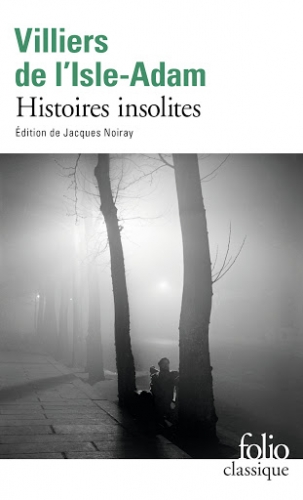
Certains critiques ont comparé Axël au Second Faust de Goethe, et sans doute est-il vrai que Villiers, à l'instar de Goethe, voulut, par son drame, donner une forme idéale à ses préoccupations philosophiques, morales ou religieuses. En rompant avec la morale conventionnelle, liée à l'utilitarisme bourgeois, et comme telle, morale sociale et nullement morale transcendante, Villiers ne va nullement sombrer dans une forme d'amoralisme ou de nihilisme; il va se forger, nous l'avons vu, une éthique initiatique, à certains égards surhumaniste, qui seule va pouvoir le sauver des périls qui le menacent. Ainsi que l'écrit Gérard de Sorval: « Au contraire de la destinée sédentaire du laïc, faite de passivité et de docile soumission à un magistère extérieur, la voie chevaleresque comporte nécessairement l'errance et le combat, comme conditions de la rencontre avec Dieu. C'est l'aventure vécue qui permet l'irruption dans la conscience et l'avènement dans l'âme de la présence divine. »(17)
Cette aventure et cet avènement sont, pour ainsi dire déjà écrits. Les épreuves sont d'autant plus nécessaires qu'elles sont déjà inscrites dans le destin de l'initié. On pourrait même dire que l'expression « par avance » est mal appropriée en cela que l'Initiation fait entrer l'initié dans l'Intemporel où, devenu ce qu'il était de toute éternité, l'avant et l'après n'ont plus aucun sens. Toutes les choses passées ou passives refleurissent alors dans les purs agissements d'un éternel présent. Il importe alors à travers les épreuves, les étapes, de décrypter peu à peu le chiffre du destin, ce qui nous ramène à l'herméneutique: « Comme patron des hérauts et des herméneutes, Hermès parle aussi par rébus, ou, si l'on préfère, il blasonne les énigmes du monde pour mieux induire et révéler leur déchiffrement. Les choses sont aussi éclatées qu'imbriquées; celui qui en donne le signe et le chiffre propose la clef de leur signification et de leur assemblage. C'est le maître du symbole dont la fonction est de passer le sens, en tous sens et par tous les sens de l'homme. »(18)

Les devises et les armoiries des héros d'Axël se laissent interpréter dans le sens du drame. Voyons d'abord la devise d'Axël: « Altius resurgere spero gemmatu »s: gonflé de sève, j'espère ressusciter plus haut. La mort des Phénix sera l'illustration de la fidélité d'Axël à sa devise ancestrale. Ressusciter plus haut, ce n'est pas seulement vaincre la mort, c'est aussi, et surtout, changer d'état d'être, c'est-à-dire « atteindre à cette identité céleste que tout guerrier recherche lorsqu'il poursuit la vraie gloire » ainsi que l'écrit Gérard de Sorval. Or, la vraie gloire appartient au royaume subtil, à l'Ether lumineux, splendeur du Vrai où toute beauté se recueille. La devise ancestrale de Sara ne s'offre pas moins à une interprétation initiatique: Macte animo ! Ultima perfulget et sola: Courage ! La seule dernière (étoile) flamboie de tous ses feux.
Cette devise s'éclaire à la description du blason lui-même: D'azur- à la tête de mort, ailée, d'argent, sur un septenaire d'étoile de même, en abyme, avec la devise courant sur les lettres du nom. Le cheminement de l'initiation, spirale prophétique qui nous entraîne vers le centre du monde, ce « point suprême » qu'évoque André Breton dans sa définition du Surréalisme, est à la fois inscrit dans le ciel, les étoiles et dans le cœur humain, en vertu des paroles attribuées à Hermès Trismégiste: « Ce qui est en haut est comme ce qui est en bas, pour faire le miracle d'une seule chose ».
« La spirale, note Gérard de Sorval, décrit le mouvement des étoiles au firmament, inverse de la rotation de la terre. Ce qui indique que le terrain de la Quête du veneur et du guerrier est au ciel, ou, pour mieux dire, c'est la terre céleste, dont le centre est l'étoile polaire et les sept astres de la Grande Ourse ». (19) Le septénaire du blason de Sara trouve ainsi son explication, ainsi que l'étoile de la devise, symbole du Pôle, c'est-à-dire du cœur de l'être, du Soi, où règne la Déïté, où l'amant, l'aimée et l'amour lui-même se confondent en une réalité unique. « La spirale de l'Initiation, écrit encore Gérard de Sorval, tourne de l'extérieur vers l'intérieur, dans le sens inverse des aiguilles d'une montre. Ce qui veut dire dans un certain sens (entendu comme signification et orientation) qu'il faut remonter le temps. Mais non pas vers le passé, car alors on l'enfermerait dans la succession chronologique, et la spirale, au lieu de resserrer ses anneaux de l'extérieur vers l'intérieur se déroulerait au contraire indéfiniment en spires de plus en plus larges. Et l'on serait alors prisonnier des anneaux de Saturne. Bien au contraire, il s'agit de remonter le flux, vers sa source qui est intemporelle, palpable à chaque instant comme éternel présent: parvenir au moyeu de la roue pour se tenir en son axe vertical immobile »(20). Aller du cercle extérieur vers le point central, remonter de l'exotérique vers l'ésotérique, de l'apparence vers l'être,- que symbolise « l'étoile polaire qui flamboie de tous ses feux »,- telle est donc l'Initiation dont le paradoxe apparent est d'être déjà réalisée avant même de débuter.
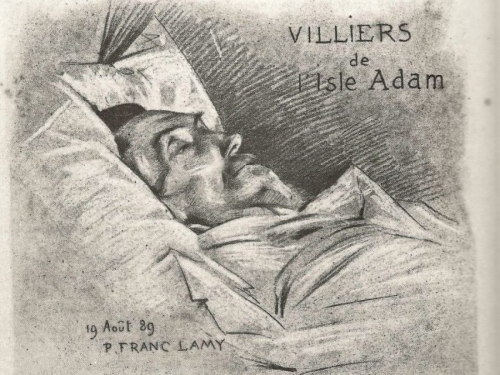
C'est ainsi que le meurtre du Commandeur, la révolte d'Axël contre la sagesse de Janus font partie du plan divin concernant la réalisation de cette sagesse. L'emprise du Sang et de l'Or n'est point une vaine dispersion pas davantage que la mort du Commandeur n'est un accident. Tout cela est écrit et Janus le sait. Gustav Meyrink, autre romancier initiatique, écrit dans Le Visage Vert: « Les hommes qui ont remis leur sort entre les mains de l'esprit qui est en eux-mêmes relèvent d'une loi spirituelle. Ils sont déclarés majeurs et échappent à la tutelle de la terre dont ils deviendront un jour les maîtres »(21). L'œuvre n'est rien sans les épreuves qui en précèdent l'accomplissement dans les obscurités mêmes de la forêt primitive que hantent les puissances de l'instinct. « Toute Quête, écrit Gérard de Sorval, commence par la forêt gaste des contes arthuriens, celle qui symbolise la multiplicité opaque, sombre, menaçante, indéfinie, où l'on s'égare sans guide, où l'on se fait dévorer par les bêtes sauvages que sont nos instincts et nos passions livrées à elles-mêmes. c'est la nature de l'état déchu de l'homme, image inverse du Jardin de l'Eden, où les forces vitales, végétales et animales ne sont plus soumises à l'ancien maître du Jardin. » (22)
Pour Villiers, l'Initiation consiste donc à laisser derrière soi ce qui fait la raison ou la déraison de vivre des humains. Il faut laisser derrière soi le monde religieux, car la dévotion souvent s'y réduit à l'obéissance aveugle à la lettre morte, au détriment de l'esprit qui vivifie. Il faut laisser derrière soi le monde tragique, si possible en sortant victorieux de l'affrontement, mais sans oublier jamais que l'action importe plus que le fruit de l'action. Il faut laisser derrière soi le monde occulte, car au terme de l'Initiation le Caché doit devenir le Révélé, de même que le connaissant s'identifie avec le connu. Enfin, il faut laisser derrière soi le monde passionnel, l'Amour étant l'illusion ultime qui cède devant la connaissance de l'unité transcendante de l'Amour, de l'Amant et de l'Aimée, au terme d'une herméneutique absolue du monde. « L'Ecu héraldique, note encore G. de Sorval, constitue par sa forme même une table d'Hermès, qui dessine la figure du mercure philosophal lorsqu'il s'est fixé dans sa puissance régénératrice et transmutatrice ». En effet: « Le bouclier, ou boucle liée, est le produit de cette coagulation, de ce lac d'amour noué: après que, dans une phase antérieure le subtil eut été séparé de l'épais, l'âme du corps, et que les deux principes eurent été purifiés dans leur propre sang, la formation du bouclier manifeste une nouvelle conjonction. Ainsi, l'apparition du blason témoigne de la venue au jour du corps subtil, fruit de cette union. » « Le blason du guerrier est médiation entre son apparence visible et son être spirituel invisible, réfraction des couleurs, ou énergies lumineuses dominantes, et des formes archétypales traduisant son identité céleste, telle qu'elle est conçue et connue de toute éternité dans la pensée divine. » (23)
Médiatrice, l'Idée de l'amour peut apparaître, dans l'œuvre de Villiers, sous une apparence paradoxale. L'Amour est à la fois ce qui perd et ce qui sauve, l'épreuve à dépasser et la puissance par laquelle il nous est donné de dépasser. L'Amour est l'illusion qu'il faut vaincre mais il est en même temps ce qui nous donne la force de vaincre toute illusion. Est-ce à dire que l'on trouverait chez Villiers une sorte de « philosophie de l'alternance », comparable, par exemple, à celle de Henry de Montherlant ? Dans l'appendice à Carnaval sacré, Montherlant écrit: « On dit qu'il m'arrive d'écrire contre moi-même. Etant tout, je suis sans cesse à l'autre bout de moi-même mais je ne puis être contre moi-même. A moins qu'un pôle soit contre l'autre pôle. » Et Montherlant ajoute, un peu plus loin: « Toujours aimer les multiples faces de chaque événement, de chaque situation. Le Zen, comme le Taoïsme, est le culte du relatif. Un Maître définit le Zen, l'art de percevoir l'étoile polaire dans le ciel méridional. On ne peut parvenir à la vérité que par l'intelligence des contraires. » (24). La connaissance intérieure de la Vérité, c'est-à-dire du Cœur, nous donne à comprendre que la logique des contraires n'est pas une logique de l'exclusion mais une logique de la complémentarité. L'amour heureux et salvateur de La Maison du Bonheur, qui protège les amants du monde extérieur, ne contredit point l'idée, développée dans Isis, que l'amour peut-être aussi un danger pour la connaissance et la sagesse. Dans La Maison du Bonheur, Paule de Luçanges et le duc Valleran de la Villethéar sont d'emblée au-delà de la vie: « Tels, ne laissant point la dignité de leurs êtres se distraire de cette pensée qu'ils habitent ce qui n'a ni commencement ni fin, ils savent grandir de toute la beauté de l'Occulte et du Surnaturel,- dont ils acceptent le sentiment,- l'intensité de leur amour. »(25)
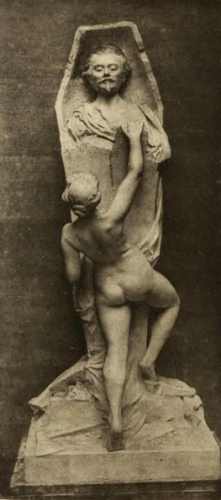 La distance prise avec le monde sauve leur amour des périls auxquels il n'eût manqué de les exposer s'ils se fussent mêlés à leurs contemporains d'une façon ou d'une autre. Mais, par bonheur: « Ayant compris de quelle atroce tristesse est fait le rire moderne, de quelles chétives fictions se repaît la sagesse purement terre à terre, de quels bruissements de hochets de puérilisent les oreilles des triviales multitudes, de quel ennui désespéré se constitue la frivole vanité du mensonge mondain, ils ont, pour ainsi dire, fait ce vœu de se contenter de leur bonheur solitaire. » (26). Hors d'atteinte, les amants de La Maison du Bonheur incarnent cette possibilité de l'amour sublime qui, dans le symbolisme initiatique du Jeu de l'Oie, correspond au Cœur flamboyant. « Plus encore, pour ceux-là dont l'amour sublime concilie en un seul être toutes les puissances, a pris tout le pouvoir sur eux, et rassemble dans l'aimé tout ce qui est attendu du dehors et du dedans, une protection invisible se manifeste: d'une certaine manière, cet amour se transporte au-delà des limites humaines normales, au-dessus des lois ordinaires et de l'enchaînement des causes et des effets, hors d'atteinte du monde. Cet amour crée autour d'eux une enceinte invisible, infranchissable, un cercle de feu, un espace sacré, comme si la célébration de ce mystère engendrait de soi-même son sanctuaire protecteur. Dans cet état, toute femme est Mercure, tout homme Souffre, leur humanité charnelle est la matière de l'œuvre, et il se forme autour d'eux un athanor invisible qui préserve le feu de leur coction des influences délétères, afin de permettre au Sel de leur amour de cristalliser et de croître » (27). Mais hormis cette radieuse possibilité de l'innocence retrouvée, et gardée, il existe d'autres formes d'amour où l'initié et l'initiée doivent guerroyer contre les enchaînements funestes de la passion.
La distance prise avec le monde sauve leur amour des périls auxquels il n'eût manqué de les exposer s'ils se fussent mêlés à leurs contemporains d'une façon ou d'une autre. Mais, par bonheur: « Ayant compris de quelle atroce tristesse est fait le rire moderne, de quelles chétives fictions se repaît la sagesse purement terre à terre, de quels bruissements de hochets de puérilisent les oreilles des triviales multitudes, de quel ennui désespéré se constitue la frivole vanité du mensonge mondain, ils ont, pour ainsi dire, fait ce vœu de se contenter de leur bonheur solitaire. » (26). Hors d'atteinte, les amants de La Maison du Bonheur incarnent cette possibilité de l'amour sublime qui, dans le symbolisme initiatique du Jeu de l'Oie, correspond au Cœur flamboyant. « Plus encore, pour ceux-là dont l'amour sublime concilie en un seul être toutes les puissances, a pris tout le pouvoir sur eux, et rassemble dans l'aimé tout ce qui est attendu du dehors et du dedans, une protection invisible se manifeste: d'une certaine manière, cet amour se transporte au-delà des limites humaines normales, au-dessus des lois ordinaires et de l'enchaînement des causes et des effets, hors d'atteinte du monde. Cet amour crée autour d'eux une enceinte invisible, infranchissable, un cercle de feu, un espace sacré, comme si la célébration de ce mystère engendrait de soi-même son sanctuaire protecteur. Dans cet état, toute femme est Mercure, tout homme Souffre, leur humanité charnelle est la matière de l'œuvre, et il se forme autour d'eux un athanor invisible qui préserve le feu de leur coction des influences délétères, afin de permettre au Sel de leur amour de cristalliser et de croître » (27). Mais hormis cette radieuse possibilité de l'innocence retrouvée, et gardée, il existe d'autres formes d'amour où l'initié et l'initiée doivent guerroyer contre les enchaînements funestes de la passion.
La dualitude de l'amour est celle du feu, qui éclaire et consume, éveille la lumière au cœur des ténèbres et réduit en cendres. La science du secret, qui se fonde sur le principe de l'alliance des contraires, nous renseigne aussi quant aux vertus cachées des sentiments. Toute chose recèle son contraire. Il y a là l'ébauche de cette loi de symétrie qui, généralisée, nous restitue à l'intuition primordiale de l'interdépendance universelle. Dans la mort, germe la vie. Le visible est le manteau de l'Invisible. Dans la lumière qui ordonne, il y a le feu qui détruit. Telle est la réalité du monde d'être toujours, pour une part apparente et pour une autre, cachée. L'Unité du monde ne peut s'expliquer par un mécanisme, comme le voudraient les positivistes, elle s'éprouve et se devine dans une interprétation sans fin. Tullia Fabriana est Isis, mais Isis demeure l'exquise Tullia, destinée à séduire et à être séduite. Tullia, pourrait-on dire, est d'autant plus Isis qu'elle est davantage séduite, de même que l'existence d'un pôle renforce et précise l'existence de l'autre pôle.
Luc-Olivier d'Algange
Notes:
(1) Axël p.203
(2) Abellio dans L'Esprit moderne et la Tradition, préface à Au seuil de l'ésotérisme de Paul Sérant, ed. Grasset, p.18
(3) Propos de Villiers au journaliste H.Leroux, cité dans Portraits de cire, ed. Lecène et Ourdin.
(4) Mircéa Eliade, Initiation, rites et sociétés secrètes, ed. Idées/Gallimard
(5) Propos rapporté à V.E Michelet, dans Figures d'évocateurs, p.231
(6)J.H Bornecque, à propos des lectures que Villiers fait de Hegel dans Henri Mondor: Eugène Lefébure.
(7) Axël,p.190
(8) Axël,p. 197
(9) Henry Corbin: L'Imagination dans le soufisme d'Ibn'Arabi, ed. Flammarion,p.206
(10) Jean Brun: Le néoplatonisme
(11) Corpus Hermeticum, Association Guillaume Budé.
(12) Axël p. 203
(13) Yves-Albert Dauge: L'Esotérisme pour quoi faire.
(14) Axël p. 203
(15) Y.A Dauge ibidem
(16) Axël p. 203
(17)G. de Sorval: La Marelle ou les Septs marches du paradis p. 69
(18) ibidem p 66
(19) ibidem p 24
(20) ibidem p 34
(21) ibidem p 70
(22) ibidem p 21
(23) ibidem P 122
(24) H. de Montherlant, Oeuvres, La pléiade p 433
(25) La Maison du Bonheur p. 148
(26) ibidem p. 149
(27) G. de Sorval: ibidem p. 96-97
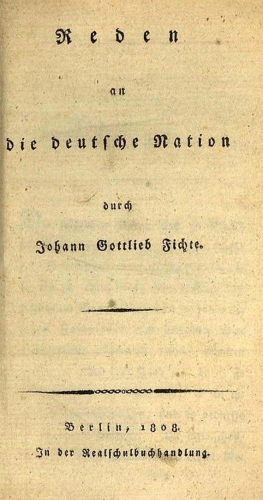 aduction française parue en 1992 à l’Imprimerie Nationale à Paris(1) et réalisée par le philosophe français, né en 1948, Alain Renaut, ce dernier se pose la question de la conception de la nation mise en avant par Fichte : celle née de la Révolution française, qui considère que le Tiers état la constitue, ou celle du romantisme allemand, « dont on a parfois soutenu qu’elle avait émergé avec la notion herderienne(2) de Volksgeist »,(3) qui veut que seuls les descendants de membres de la nation appartiennent à cette dernière ?
aduction française parue en 1992 à l’Imprimerie Nationale à Paris(1) et réalisée par le philosophe français, né en 1948, Alain Renaut, ce dernier se pose la question de la conception de la nation mise en avant par Fichte : celle née de la Révolution française, qui considère que le Tiers état la constitue, ou celle du romantisme allemand, « dont on a parfois soutenu qu’elle avait émergé avec la notion herderienne(2) de Volksgeist »,(3) qui veut que seuls les descendants de membres de la nation appartiennent à cette dernière ?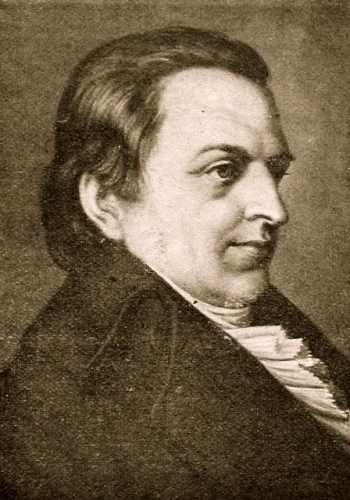 « Si la nationalité procède d’un acte d’adhésion volontaire, l’accès à cette nationalité relève d’un libre choix : dans la logique révolutionnaire, il suffit de déclarer son adhésion aux droits de l’homme et, à partir de 1791, à la Constitution, pour devenir français.(6)
« Si la nationalité procède d’un acte d’adhésion volontaire, l’accès à cette nationalité relève d’un libre choix : dans la logique révolutionnaire, il suffit de déclarer son adhésion aux droits de l’homme et, à partir de 1791, à la Constitution, pour devenir français.(6)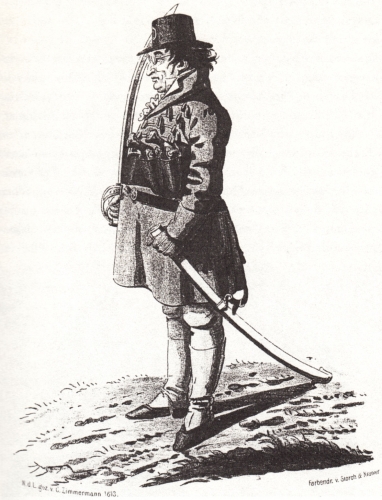 L’idée fichtéenne de nation
L’idée fichtéenne de nation




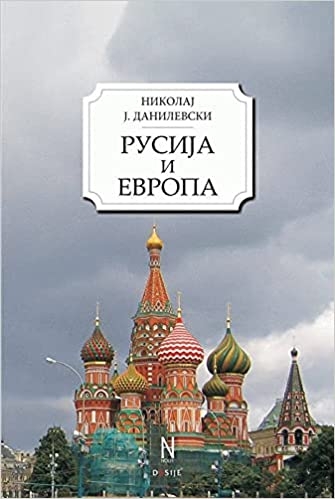
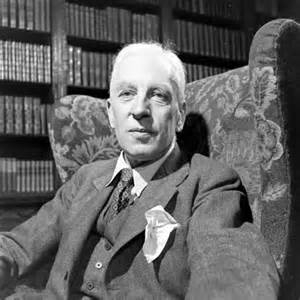

 del.icio.us
del.icio.us
 Digg
Digg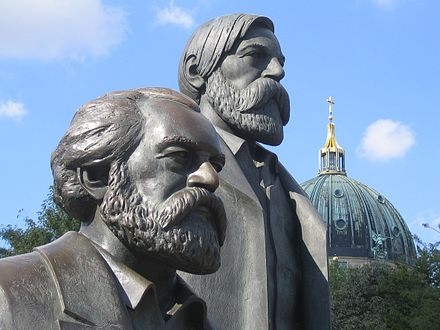
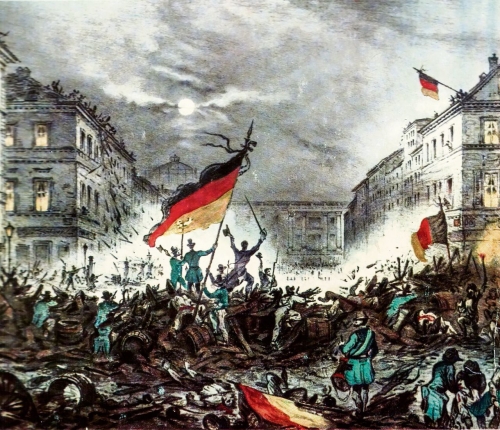
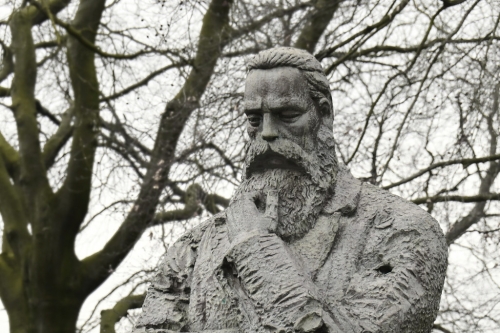
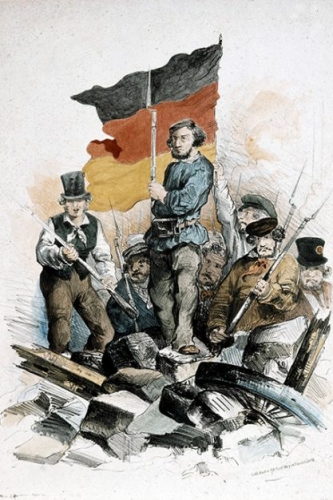

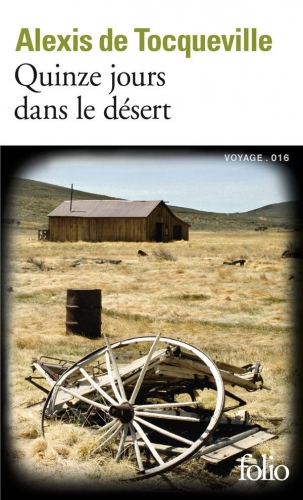
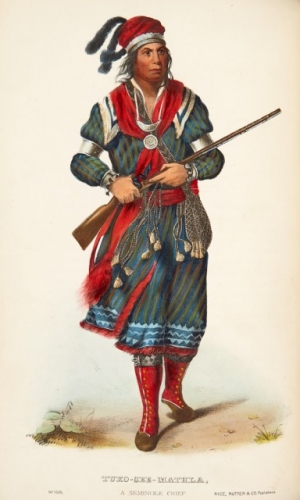

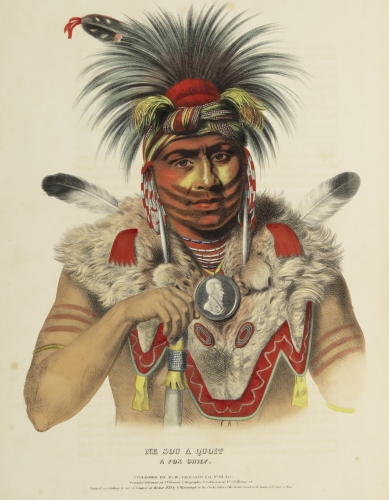


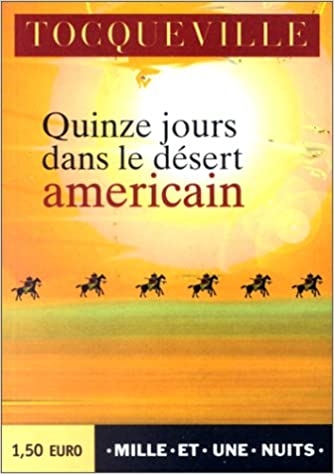

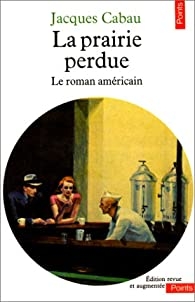 Puis notre voyageur redevient poète et évoque la similitude entre cette forêt et le grand océan. On pense à Melville, à Moby Dick bien sûr et au si bel essai de Jacques Cabau sur la Prairie perdue :
Puis notre voyageur redevient poète et évoque la similitude entre cette forêt et le grand océan. On pense à Melville, à Moby Dick bien sûr et au si bel essai de Jacques Cabau sur la Prairie perdue :
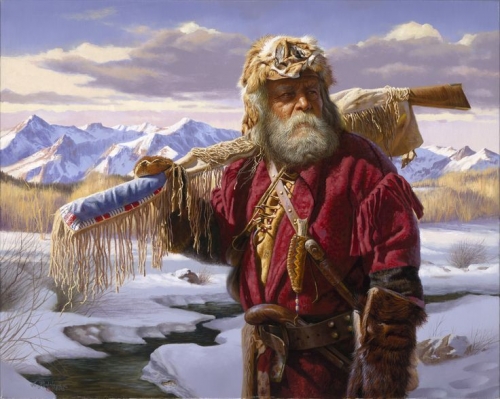
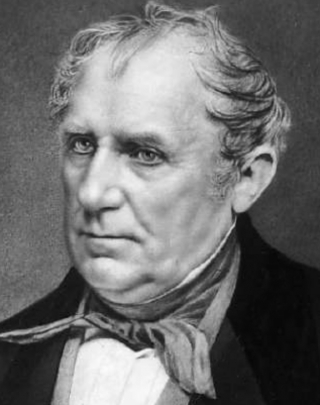
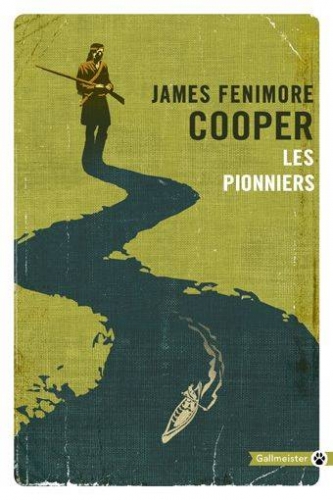
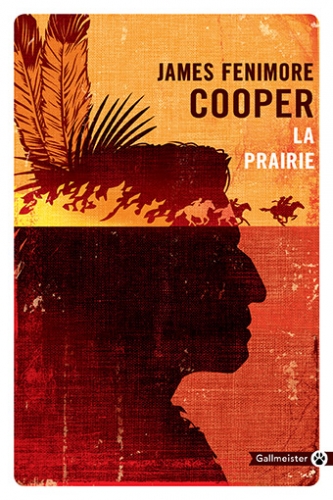
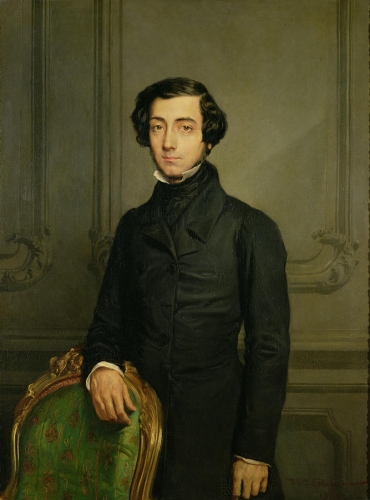
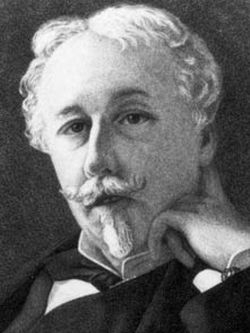
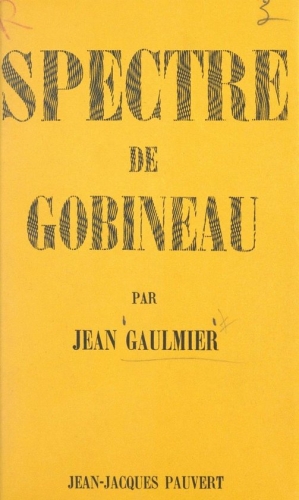
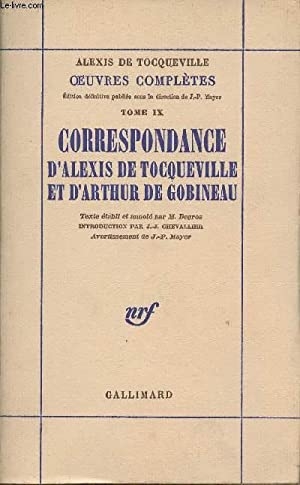
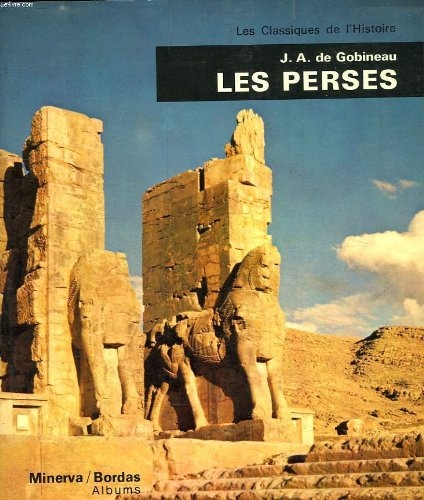
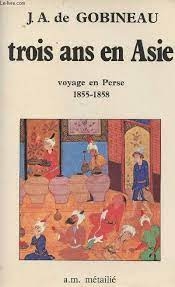 On est déjà sous la Ve république :
On est déjà sous la Ve république :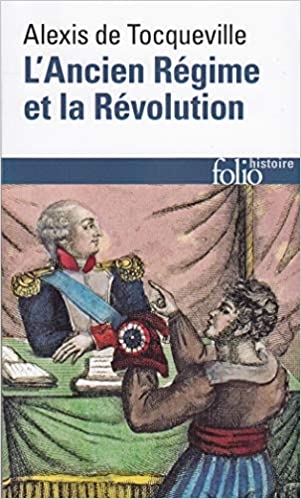 Gobineau lit le livre de Tocqueville sur l’Ancien régime et la révolution (ô France sinistre, voyez mon coq hérétique) ; voici ses commentaires cruels :
Gobineau lit le livre de Tocqueville sur l’Ancien régime et la révolution (ô France sinistre, voyez mon coq hérétique) ; voici ses commentaires cruels :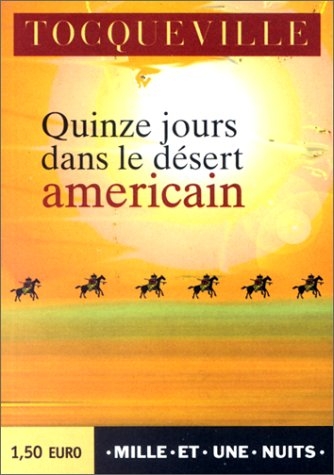 Soyons ironiques pour terminer. Voici ce que Tocqueville écrit du métis dans ses Quinze jours dans le désert (un des textes les plus beaux qui soient ; on y reviendra) :
Soyons ironiques pour terminer. Voici ce que Tocqueville écrit du métis dans ses Quinze jours dans le désert (un des textes les plus beaux qui soient ; on y reviendra) :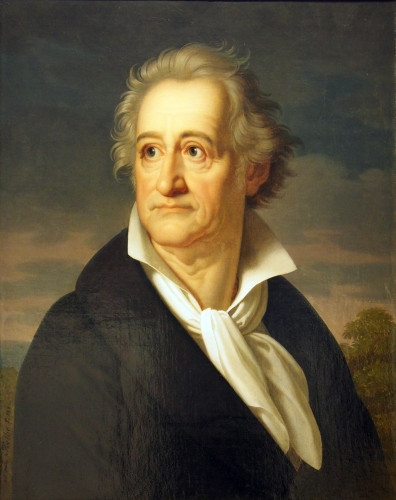
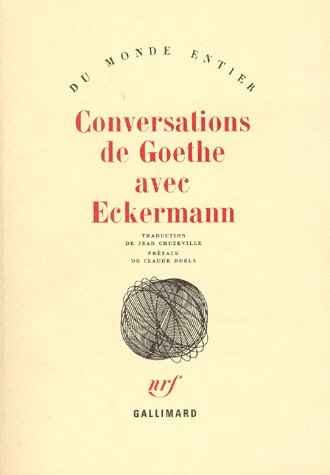 D’un coup le grand homme olympien se sent neurasthénique :
D’un coup le grand homme olympien se sent neurasthénique :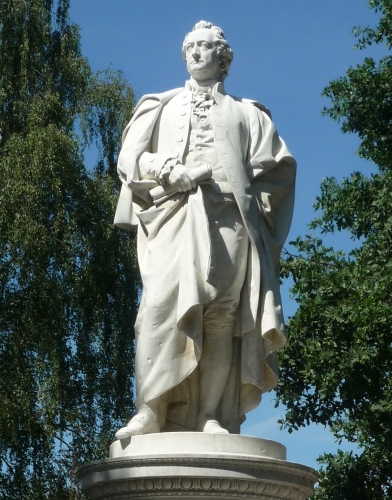
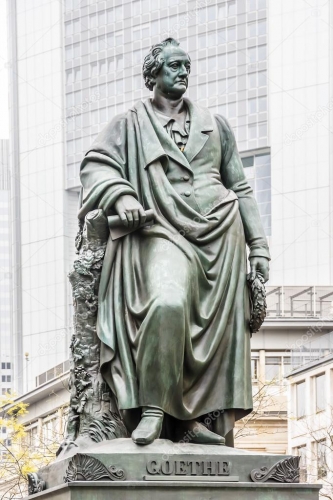
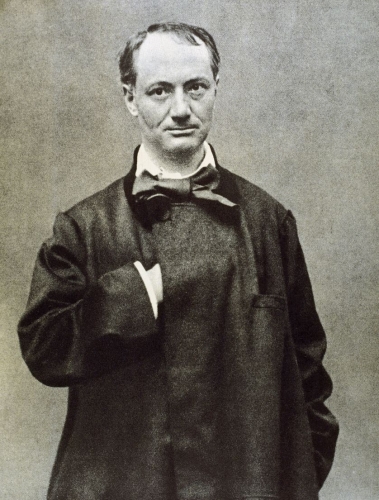
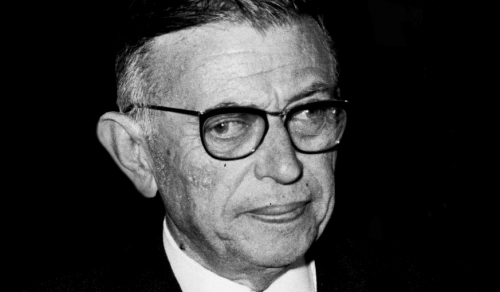
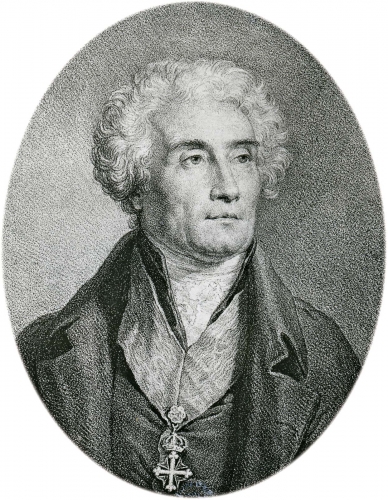
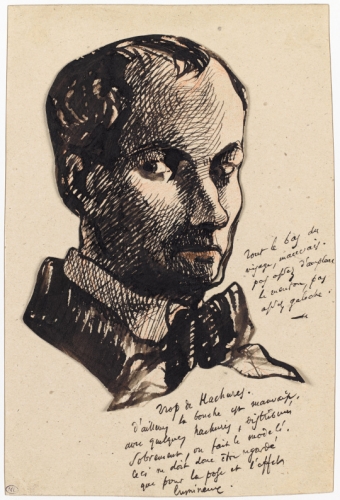
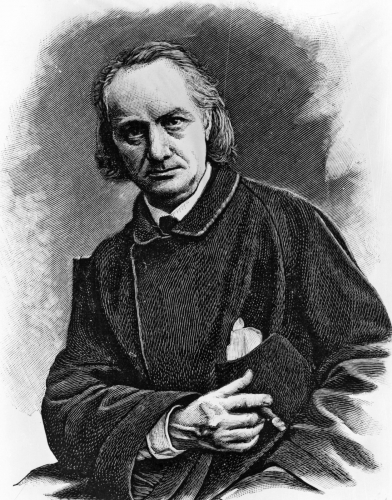
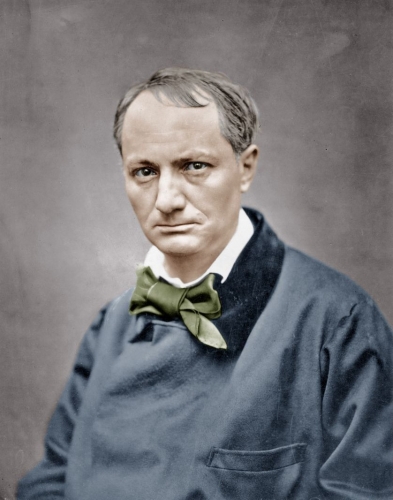
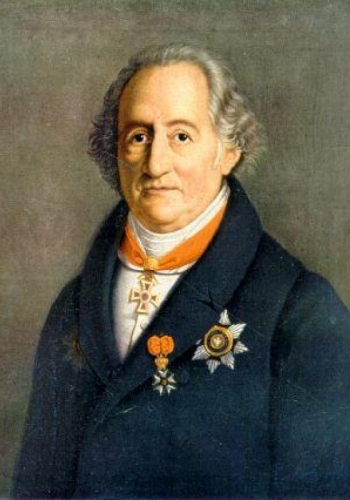
 « Léopold Kohr est un peu comme René Girard. Son explication doit tout expliquer. Voici ce qu’il écrit au début de son ''effondrement des nations'' :
« Léopold Kohr est un peu comme René Girard. Son explication doit tout expliquer. Voici ce qu’il écrit au début de son ''effondrement des nations'' :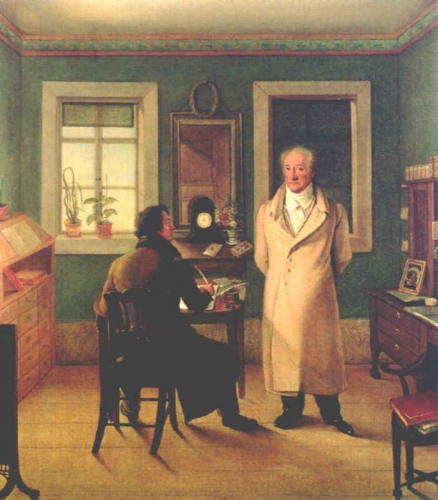



 De ces nostalgies et de ces pressentiments l'œuvre de Villiers de l'Isle-Adam magnifiquement témoigne, la création littéraire étant pour lui identique à l'Œuvre alchimique par laquelle l'individu se délivre à la fois du monde et de lui-même. Toutefois, l'état général du monde étant à la déchéance et à la trahison, cette délivrance ne pouvant plus s'accomplir que par exception, elle sera désormais limitée à cette élite ultime dont la sagesse implique une lucide révolte contre le monde moderne et « l'hypnotisme du Progrès » qui, ainsi que nous le montrent L'Affichage céleste et La Machine à analyser le dernier soupir, sont allés jusqu'à profaner le Ciel et la Mort !
De ces nostalgies et de ces pressentiments l'œuvre de Villiers de l'Isle-Adam magnifiquement témoigne, la création littéraire étant pour lui identique à l'Œuvre alchimique par laquelle l'individu se délivre à la fois du monde et de lui-même. Toutefois, l'état général du monde étant à la déchéance et à la trahison, cette délivrance ne pouvant plus s'accomplir que par exception, elle sera désormais limitée à cette élite ultime dont la sagesse implique une lucide révolte contre le monde moderne et « l'hypnotisme du Progrès » qui, ainsi que nous le montrent L'Affichage céleste et La Machine à analyser le dernier soupir, sont allés jusqu'à profaner le Ciel et la Mort ! 

 « Epouse en toi la destruction de la Nature; résiste à ses aimants mortels. Sois la privation ! Renonce ! Délivre-toi. Sois ta propre victime ! Consacre-toi sur les brasiers d'amour de la Science auguste pour y mourir, en ascète de la mort des phénix. Ainsi réfléchissant l'essentielle valeur de tes jours sur la Loi, tous leurs moments pénétrés de sa réfraction, participeront de ta pérennité. Ainsi tu annuleras en toi, autour de toi, toute limite ! Et oublieux à jamais de ce qui fut l'illusion de toi-même, ayant conquis, libre enfin, l'idée de ton être, tu deviendras dans l'Intemporel, esprit purifié, distincte essence en l'esprit absolu,- le consort même de ce que tu appelles Déïté. »(8)
« Epouse en toi la destruction de la Nature; résiste à ses aimants mortels. Sois la privation ! Renonce ! Délivre-toi. Sois ta propre victime ! Consacre-toi sur les brasiers d'amour de la Science auguste pour y mourir, en ascète de la mort des phénix. Ainsi réfléchissant l'essentielle valeur de tes jours sur la Loi, tous leurs moments pénétrés de sa réfraction, participeront de ta pérennité. Ainsi tu annuleras en toi, autour de toi, toute limite ! Et oublieux à jamais de ce qui fut l'illusion de toi-même, ayant conquis, libre enfin, l'idée de ton être, tu deviendras dans l'Intemporel, esprit purifié, distincte essence en l'esprit absolu,- le consort même de ce que tu appelles Déïté. »(8)



 La distance prise avec le monde sauve leur amour des périls auxquels il n'eût manqué de les exposer s'ils se fussent mêlés à leurs contemporains d'une façon ou d'une autre. Mais, par bonheur: « Ayant compris de quelle atroce tristesse est fait le rire moderne, de quelles chétives fictions se repaît la sagesse purement terre à terre, de quels bruissements de hochets de puérilisent les oreilles des triviales multitudes, de quel ennui désespéré se constitue la frivole vanité du mensonge mondain, ils ont, pour ainsi dire, fait ce vœu de se contenter de leur bonheur solitaire. » (26). Hors d'atteinte, les amants de La Maison du Bonheur incarnent cette possibilité de l'amour sublime qui, dans le symbolisme initiatique du Jeu de l'Oie, correspond au Cœur flamboyant. « Plus encore, pour ceux-là dont l'amour sublime concilie en un seul être toutes les puissances, a pris tout le pouvoir sur eux, et rassemble dans l'aimé tout ce qui est attendu du dehors et du dedans, une protection invisible se manifeste: d'une certaine manière, cet amour se transporte au-delà des limites humaines normales, au-dessus des lois ordinaires et de l'enchaînement des causes et des effets, hors d'atteinte du monde. Cet amour crée autour d'eux une enceinte invisible, infranchissable, un cercle de feu, un espace sacré, comme si la célébration de ce mystère engendrait de soi-même son sanctuaire protecteur. Dans cet état, toute femme est Mercure, tout homme Souffre, leur humanité charnelle est la matière de l'œuvre, et il se forme autour d'eux un athanor invisible qui préserve le feu de leur coction des influences délétères, afin de permettre au Sel de leur amour de cristalliser et de croître » (27). Mais hormis cette radieuse possibilité de l'innocence retrouvée, et gardée, il existe d'autres formes d'amour où l'initié et l'initiée doivent guerroyer contre les enchaînements funestes de la passion.
La distance prise avec le monde sauve leur amour des périls auxquels il n'eût manqué de les exposer s'ils se fussent mêlés à leurs contemporains d'une façon ou d'une autre. Mais, par bonheur: « Ayant compris de quelle atroce tristesse est fait le rire moderne, de quelles chétives fictions se repaît la sagesse purement terre à terre, de quels bruissements de hochets de puérilisent les oreilles des triviales multitudes, de quel ennui désespéré se constitue la frivole vanité du mensonge mondain, ils ont, pour ainsi dire, fait ce vœu de se contenter de leur bonheur solitaire. » (26). Hors d'atteinte, les amants de La Maison du Bonheur incarnent cette possibilité de l'amour sublime qui, dans le symbolisme initiatique du Jeu de l'Oie, correspond au Cœur flamboyant. « Plus encore, pour ceux-là dont l'amour sublime concilie en un seul être toutes les puissances, a pris tout le pouvoir sur eux, et rassemble dans l'aimé tout ce qui est attendu du dehors et du dedans, une protection invisible se manifeste: d'une certaine manière, cet amour se transporte au-delà des limites humaines normales, au-dessus des lois ordinaires et de l'enchaînement des causes et des effets, hors d'atteinte du monde. Cet amour crée autour d'eux une enceinte invisible, infranchissable, un cercle de feu, un espace sacré, comme si la célébration de ce mystère engendrait de soi-même son sanctuaire protecteur. Dans cet état, toute femme est Mercure, tout homme Souffre, leur humanité charnelle est la matière de l'œuvre, et il se forme autour d'eux un athanor invisible qui préserve le feu de leur coction des influences délétères, afin de permettre au Sel de leur amour de cristalliser et de croître » (27). Mais hormis cette radieuse possibilité de l'innocence retrouvée, et gardée, il existe d'autres formes d'amour où l'initié et l'initiée doivent guerroyer contre les enchaînements funestes de la passion.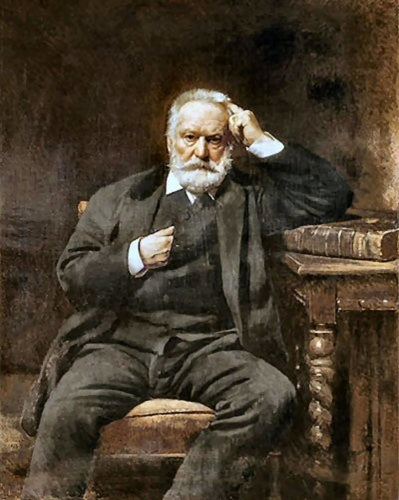
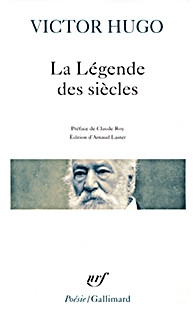 Prenez ces quelques lignes comme un refus de souffler les bougies d'un poète qui allume encore dans la nuit de nos cœurs des flambeaux. Non, Victor Hugo n'est pas ce poète « moderne », « démocrate », « progressiste », précurseur de la monnaie unique et du monde mondialisé ! Victor Hugo n'est pas davantage ce paillard sympathique, ce républicain jacobin où d'autres trouvent leur miel et leur fiel. Victor Hugo, s'il vous en souvient, est l'auteur de La Légende des Siècles.
Prenez ces quelques lignes comme un refus de souffler les bougies d'un poète qui allume encore dans la nuit de nos cœurs des flambeaux. Non, Victor Hugo n'est pas ce poète « moderne », « démocrate », « progressiste », précurseur de la monnaie unique et du monde mondialisé ! Victor Hugo n'est pas davantage ce paillard sympathique, ce républicain jacobin où d'autres trouvent leur miel et leur fiel. Victor Hugo, s'il vous en souvient, est l'auteur de La Légende des Siècles.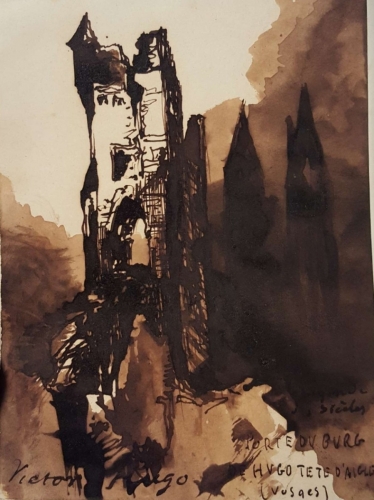
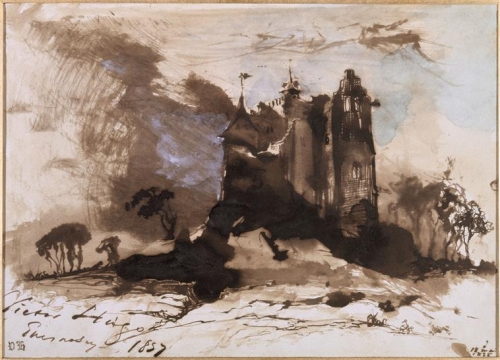
 Gustave Thibon voit à juste titre dans ces quatre vers, qui résument le projet de La Légende des siècles, une condamnation radicale du progressisme. Cet « avenir sacré qu'elles n'ont pas », comment ne pas y reconnaître la fallacieuse promesse des lendemains qui chantent, internationalistes ou « mondialistes », de tous les totalitarismes progressistes ? Ce qui importe par-dessus tout c'est: « la sombre fidélité pour les choses tombées ». La victoire appartient aux heures menteuses, mais seulement pour un temps, dans l'interrègne: « Pour les vaincus la lutte est un grand bonheur triste/ Qu'il faut faire durer le plus longtemps qu'on peut ». Rien n'est plus étranger à la mentalité progressiste que ce pessimisme actif qui se transfigure en espérance platonicienne: « Qu'est-ce que tout cela qui n'est pas éternel ? ». Suivons encore Gustave Thibon, lorsqu'il nous fait remarquer, dans ses entretiens avec Philippe Barthelet, que « tout Platon est là: des trois transcendantaux, la beauté seule a le privilège de l'apparence sensible »:
Gustave Thibon voit à juste titre dans ces quatre vers, qui résument le projet de La Légende des siècles, une condamnation radicale du progressisme. Cet « avenir sacré qu'elles n'ont pas », comment ne pas y reconnaître la fallacieuse promesse des lendemains qui chantent, internationalistes ou « mondialistes », de tous les totalitarismes progressistes ? Ce qui importe par-dessus tout c'est: « la sombre fidélité pour les choses tombées ». La victoire appartient aux heures menteuses, mais seulement pour un temps, dans l'interrègne: « Pour les vaincus la lutte est un grand bonheur triste/ Qu'il faut faire durer le plus longtemps qu'on peut ». Rien n'est plus étranger à la mentalité progressiste que ce pessimisme actif qui se transfigure en espérance platonicienne: « Qu'est-ce que tout cela qui n'est pas éternel ? ». Suivons encore Gustave Thibon, lorsqu'il nous fait remarquer, dans ses entretiens avec Philippe Barthelet, que « tout Platon est là: des trois transcendantaux, la beauté seule a le privilège de l'apparence sensible »: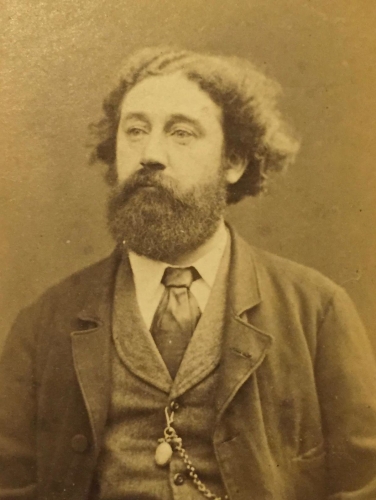
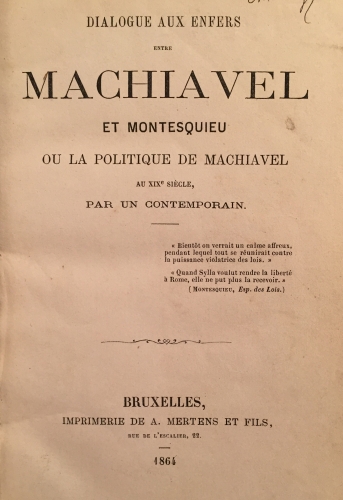
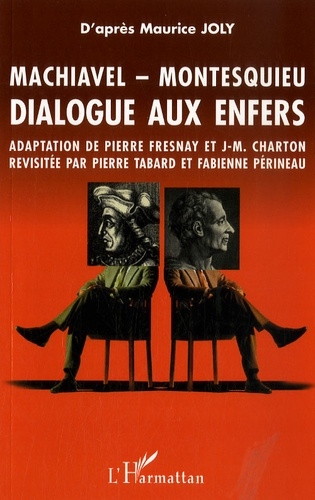 Machiavel conseille un peu de chaos, un peu de dissonance et d’incohérences pour contrôler la masse :
Machiavel conseille un peu de chaos, un peu de dissonance et d’incohérences pour contrôler la masse :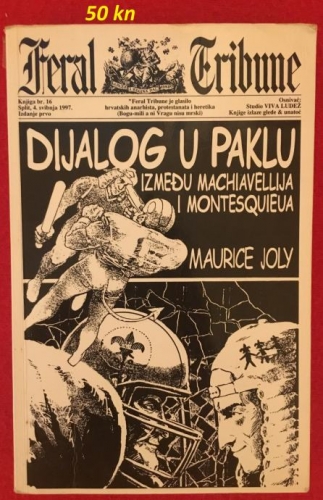 Les réformes ? Mais l’Etat adore réformer la France, l’Europe, le monde, les retraites :
Les réformes ? Mais l’Etat adore réformer la France, l’Europe, le monde, les retraites :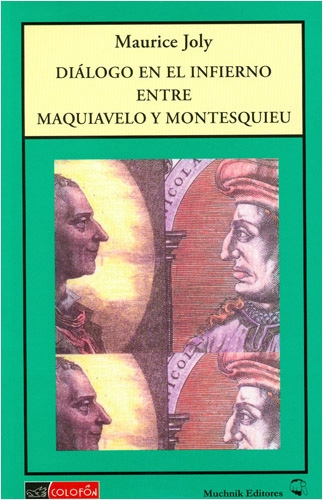 Enfin le peuple maso aime et comprend les coups, le 11 septembre, et tous les Bataclan :
Enfin le peuple maso aime et comprend les coups, le 11 septembre, et tous les Bataclan :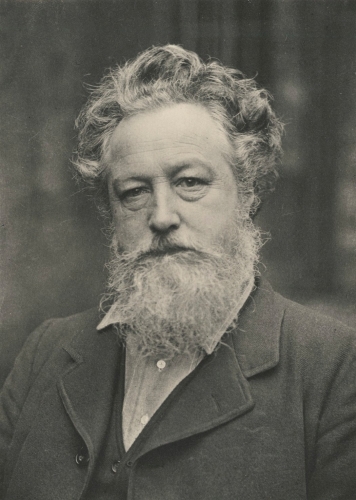
 Lors d’un récent colloque du parti dit «socialiste », des observateurs ironiques ont pu noter que l’invocation du progrès et du développement avait remplacé dans les discours, la classe ouvrière et la justice sociale. Et si les orateurs prétendaient parfois se préoccuper de « la question écologique », ils ne contestaient jamais le dogme de la croissance ni ne s’interrogeaient sur les finalités de la production matérielle. Le système des objets, les impératifs du marché ou le déploiement sans entrave des forces productives semblent aujourd’hui des horizons indépassables pour la plupart des partis qui se réclament encore du socialisme ou se revendiquent héritiers de l’ancien mouvement ouvrier. Technocrates de la social-démocratie occidentale ou militants des derniers groupuscules marxistes-léninistes, ils sont des fidèles obéissants de la religion du progrès, qui n’imaginent pas d’autres mondes possibles hors du cercle de la raison marchande ou industrialiste.
Lors d’un récent colloque du parti dit «socialiste », des observateurs ironiques ont pu noter que l’invocation du progrès et du développement avait remplacé dans les discours, la classe ouvrière et la justice sociale. Et si les orateurs prétendaient parfois se préoccuper de « la question écologique », ils ne contestaient jamais le dogme de la croissance ni ne s’interrogeaient sur les finalités de la production matérielle. Le système des objets, les impératifs du marché ou le déploiement sans entrave des forces productives semblent aujourd’hui des horizons indépassables pour la plupart des partis qui se réclament encore du socialisme ou se revendiquent héritiers de l’ancien mouvement ouvrier. Technocrates de la social-démocratie occidentale ou militants des derniers groupuscules marxistes-léninistes, ils sont des fidèles obéissants de la religion du progrès, qui n’imaginent pas d’autres mondes possibles hors du cercle de la raison marchande ou industrialiste.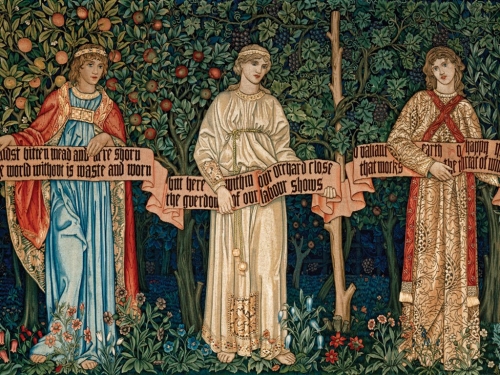
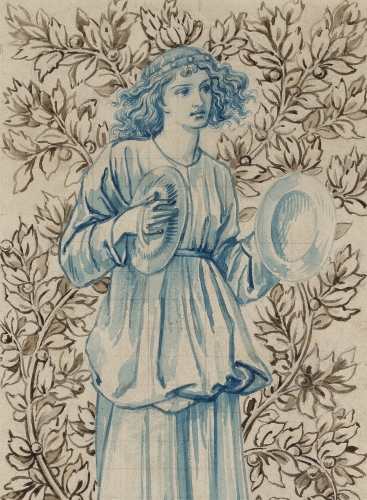
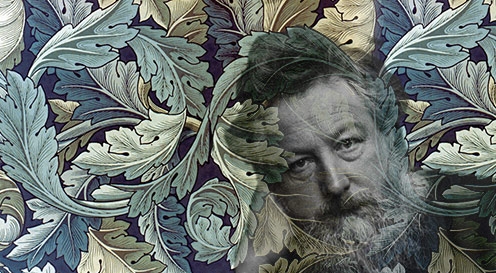
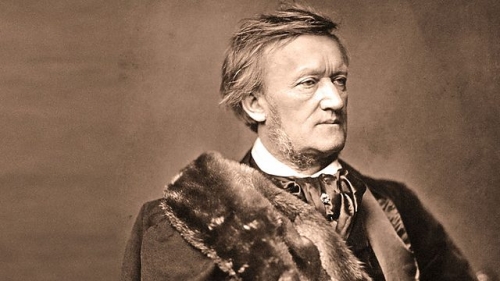
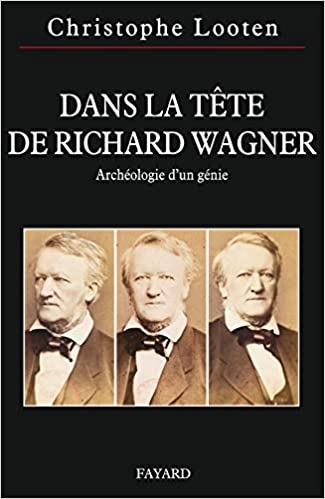 Conférence de Christophe Looten, enregistrée le samedi 5 avril 2014 à la Bibliothèque Municipale de la Part-Dieu (Lyon) dans le cadre des conférences publiques du Cercle Richard Wagner-Lyon. Par le courant philosophique appelé « Idéalisme allemand » et les idées des penseurs comme Hegel, Fichte ou Kant, les Allemands de cette époque se voyaient symboliquement les descendants des anciens Grecs. L’œuvre théâtrale de Wagner magnifie cette vision d’une façon si absolue qu’on ne peut en saisir toute la profondeur qu’en la considérant avec toutes ses implications philosophiques. Son art est une réponse éloquente à la question : « Qu’est-ce qui est allemand ? » Christophe Looten est l’auteur de nombreuses œuvres vocales, instrumentales et symphoniques qui sont jouées en France et à l’étranger et qui ont valu diverses récompenses et distinctions. Il est également auteur d’écrits sur la musique et les compositeurs, en particulier Richard Wagner, avec deux ouvrages récents dont la valeur a été unanimement reconnues :
Conférence de Christophe Looten, enregistrée le samedi 5 avril 2014 à la Bibliothèque Municipale de la Part-Dieu (Lyon) dans le cadre des conférences publiques du Cercle Richard Wagner-Lyon. Par le courant philosophique appelé « Idéalisme allemand » et les idées des penseurs comme Hegel, Fichte ou Kant, les Allemands de cette époque se voyaient symboliquement les descendants des anciens Grecs. L’œuvre théâtrale de Wagner magnifie cette vision d’une façon si absolue qu’on ne peut en saisir toute la profondeur qu’en la considérant avec toutes ses implications philosophiques. Son art est une réponse éloquente à la question : « Qu’est-ce qui est allemand ? » Christophe Looten est l’auteur de nombreuses œuvres vocales, instrumentales et symphoniques qui sont jouées en France et à l’étranger et qui ont valu diverses récompenses et distinctions. Il est également auteur d’écrits sur la musique et les compositeurs, en particulier Richard Wagner, avec deux ouvrages récents dont la valeur a été unanimement reconnues : 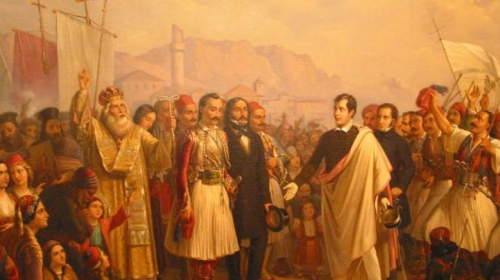
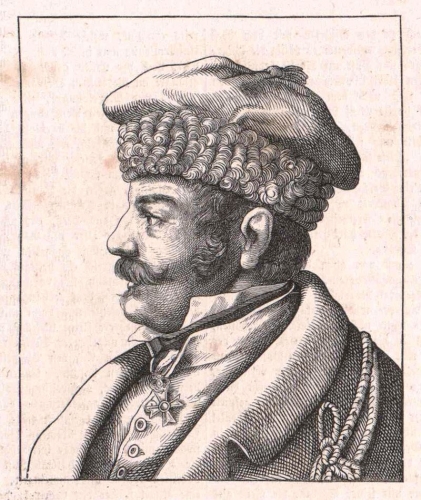
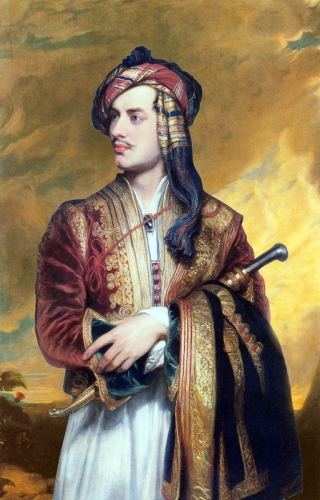
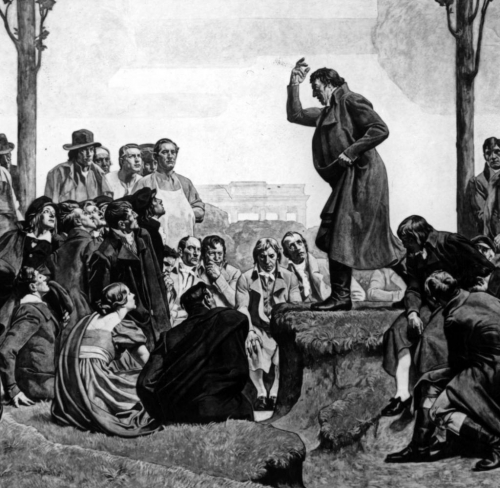
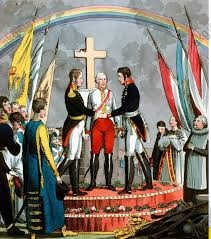
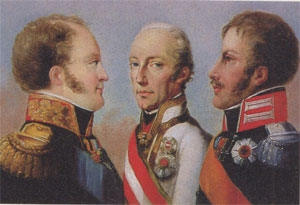
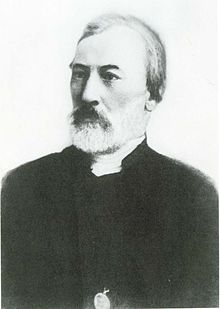
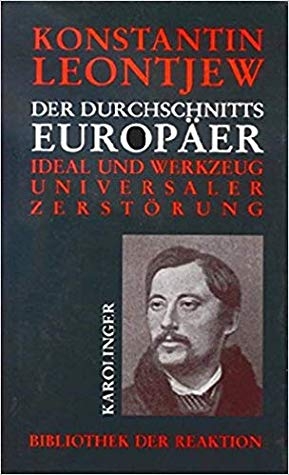 Qui, parmi les lecteurs contemporains, souhaite encore lire de pareilles formules, et qui, parmi les marchands qui font profession de fournir de la matière imprimée, aurait encore envie de fourguer une telle camelote ? Non, soyons sérieux, ce genre de sortie, et plus encore le comportement qu'elle suppose, datent d'une autre époque, époque, fort heureusement, révolue pour nous, qui sommes gens évolués et accomplis. En outre, le bonhomme eu l'impudence de critiquer Dostoïevski ! Du moins, ce qui à notre époque revient au même, certaines idées avancées par l'auteur des Frères Karamazov. Ainsi l'obscur et impudent, à propos de Crime et châtiment, a-t-il osé écrire que «Sonia... n'a pas lu les Pères de l'Église» ! Voilà qui le rend «suspect» et par trop réactionnaire, même pour les chrétiens ! Pourtant Leontiev ne dit pas là autre chose que Chesterton lorsque celui-ci écrit qu’«En dehors de l'Église les Évangiles sont un poison», proposition raisonnable et si juste de la part d'un Britannique. «Toutes les idées modernes sont des idées chrétiennes devenues folles» : là encore, l'amateur éclairé opinera du chef et se régalera d'une telle sagacité bien audacieuse. Mais que ce grand Russe, petit écrivain compromis par sa «proximité avec le régime», se permette d'écorcher, pour les mêmes motifs, ce que la Russie nous a donné de meilleur, qu'il s'en prenne à ce style psychologique qui a fait, justement, le régal des belles âmes, voilà ce qui est proprement impardonnable.
Qui, parmi les lecteurs contemporains, souhaite encore lire de pareilles formules, et qui, parmi les marchands qui font profession de fournir de la matière imprimée, aurait encore envie de fourguer une telle camelote ? Non, soyons sérieux, ce genre de sortie, et plus encore le comportement qu'elle suppose, datent d'une autre époque, époque, fort heureusement, révolue pour nous, qui sommes gens évolués et accomplis. En outre, le bonhomme eu l'impudence de critiquer Dostoïevski ! Du moins, ce qui à notre époque revient au même, certaines idées avancées par l'auteur des Frères Karamazov. Ainsi l'obscur et impudent, à propos de Crime et châtiment, a-t-il osé écrire que «Sonia... n'a pas lu les Pères de l'Église» ! Voilà qui le rend «suspect» et par trop réactionnaire, même pour les chrétiens ! Pourtant Leontiev ne dit pas là autre chose que Chesterton lorsque celui-ci écrit qu’«En dehors de l'Église les Évangiles sont un poison», proposition raisonnable et si juste de la part d'un Britannique. «Toutes les idées modernes sont des idées chrétiennes devenues folles» : là encore, l'amateur éclairé opinera du chef et se régalera d'une telle sagacité bien audacieuse. Mais que ce grand Russe, petit écrivain compromis par sa «proximité avec le régime», se permette d'écorcher, pour les mêmes motifs, ce que la Russie nous a donné de meilleur, qu'il s'en prenne à ce style psychologique qui a fait, justement, le régal des belles âmes, voilà ce qui est proprement impardonnable. 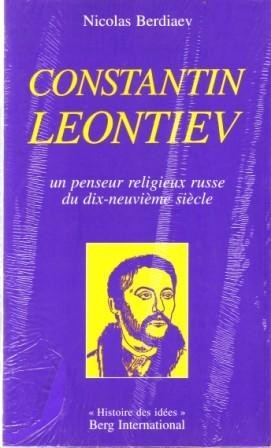 Et puis surtout, que pourrions-nous bien en faire de ce furieux vieux bonhomme qui a osé écrire
Et puis surtout, que pourrions-nous bien en faire de ce furieux vieux bonhomme qui a osé écrire 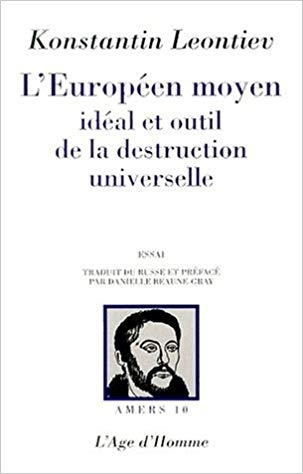 Selon lui, cette loi quasi cyclique s'observe dans tous les domaines des civilisations historiques. Et, ce que nous appelons unanimement progrès, il le distingue très nettement de ce processus de développement, le nommant «diffusion» ou «propagation» et l'attachant à cette phase dissolvante de «simplification syncrétique secondaire» : «[…] l'idée même de développement correspond, dans les sciences exactes d'où elle a été transférée dans le champs historique, à un processus complexe et, remarquons-le, souvent contraire au processus de diffusion, de propagation, en tant que processus hostile à ce mécanisme de diffusion» (4).
Selon lui, cette loi quasi cyclique s'observe dans tous les domaines des civilisations historiques. Et, ce que nous appelons unanimement progrès, il le distingue très nettement de ce processus de développement, le nommant «diffusion» ou «propagation» et l'attachant à cette phase dissolvante de «simplification syncrétique secondaire» : «[…] l'idée même de développement correspond, dans les sciences exactes d'où elle a été transférée dans le champs historique, à un processus complexe et, remarquons-le, souvent contraire au processus de diffusion, de propagation, en tant que processus hostile à ce mécanisme de diffusion» (4).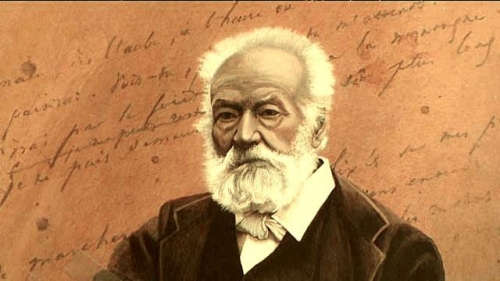
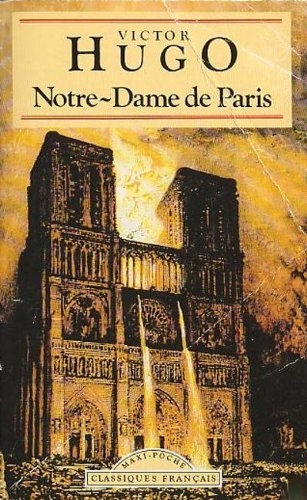 « Quand la mémoire des premières races se sentit surchargée, quand le bagage des souvenirs du genre humain devint si lourd et si confus que la parole, nue et volante, risqua d’en perdre en chemin, on les transcrivit sur le sol de la façon la plus visible, la plus durable et la plus naturelle à la fois. On scella chaque tradition sous un monument. » Ainsi Victor Hugo évoque-t-il le premier passage d’une ère d’oralité à un âge où l’architecture devient « le grand livre de l’humanité ». Souvenons-nous cependant de la parole biblique concernant la pierre que les bâtisseurs ont écartée et qui est justement la pierre d’angle. Le risque de « perdre en chemin » un élément essentiel deviendrait-il réalité dès que s’élèvent les premiers menhirs celtiques que l’on retrouve « dans la Sibérie d’Asie » ou « les pampas d’Amérique » ?
« Quand la mémoire des premières races se sentit surchargée, quand le bagage des souvenirs du genre humain devint si lourd et si confus que la parole, nue et volante, risqua d’en perdre en chemin, on les transcrivit sur le sol de la façon la plus visible, la plus durable et la plus naturelle à la fois. On scella chaque tradition sous un monument. » Ainsi Victor Hugo évoque-t-il le premier passage d’une ère d’oralité à un âge où l’architecture devient « le grand livre de l’humanité ». Souvenons-nous cependant de la parole biblique concernant la pierre que les bâtisseurs ont écartée et qui est justement la pierre d’angle. Le risque de « perdre en chemin » un élément essentiel deviendrait-il réalité dès que s’élèvent les premiers menhirs celtiques que l’on retrouve « dans la Sibérie d’Asie » ou « les pampas d’Amérique » ?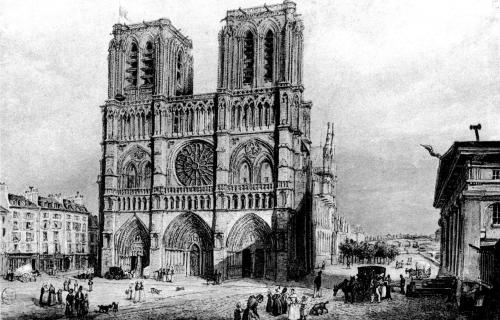
 Le thème du Graal est l’équivalent païen, au sens noble du terme, de la pierre d’angle biblique rejetée par les bâtisseurs. Énigmatique demeure à mes yeux cette phrase de René Guénon : « Le Graal ne peut être qu’un zodiaque. » Mais je suis convaincu que, pour déchirer le voile qui recouvre le mystère des origines, pour retrouver ce « grain d’or » dont parle l’astronome Kepler (1571 – 1630), il faut emprunter la voie de l’astrologie, domaine impensé de notre mouvance intellectuelle (du moins à ma connaissance), art antique vénérable raillé par La Fontaine et Voltaire, discipline dévoyée depuis quatre siècles, hormis quelques soubresauts : le marquis de Boulainvilliers (1658 – 1722), une école française aux alentours de 1900 (Caslant, Choisnard, Boudineau), une école belge (avec Gustave-Lambert Brahy comme figure de proue), les travaux plus récents de Gauquelin et Barbault (tous deux nés en 1920). Si le Graal est un vase, ce n’est pas exclusivement parce que Joseph d’Arimathie y a recueilli le sang de Jésus crucifié, mais c’est, par-delà sa dérivation chrétienne, par son identification plus générale à un récipient recueillant la pluie des influences cosmiques. Cet élargissement de la signification du Graal s’inscrit, soit dans la « Préhistoire partagée (Raphaël Nicolle) » des peuples indo-européens, soit dans une proto-histoire plus ample, ainsi qu’en témoigne le rapprochement d’Hugo entre les pierres levées d’Europe occidentale et celle de l’Asie sibérienne et de l’Argentine.
Le thème du Graal est l’équivalent païen, au sens noble du terme, de la pierre d’angle biblique rejetée par les bâtisseurs. Énigmatique demeure à mes yeux cette phrase de René Guénon : « Le Graal ne peut être qu’un zodiaque. » Mais je suis convaincu que, pour déchirer le voile qui recouvre le mystère des origines, pour retrouver ce « grain d’or » dont parle l’astronome Kepler (1571 – 1630), il faut emprunter la voie de l’astrologie, domaine impensé de notre mouvance intellectuelle (du moins à ma connaissance), art antique vénérable raillé par La Fontaine et Voltaire, discipline dévoyée depuis quatre siècles, hormis quelques soubresauts : le marquis de Boulainvilliers (1658 – 1722), une école française aux alentours de 1900 (Caslant, Choisnard, Boudineau), une école belge (avec Gustave-Lambert Brahy comme figure de proue), les travaux plus récents de Gauquelin et Barbault (tous deux nés en 1920). Si le Graal est un vase, ce n’est pas exclusivement parce que Joseph d’Arimathie y a recueilli le sang de Jésus crucifié, mais c’est, par-delà sa dérivation chrétienne, par son identification plus générale à un récipient recueillant la pluie des influences cosmiques. Cet élargissement de la signification du Graal s’inscrit, soit dans la « Préhistoire partagée (Raphaël Nicolle) » des peuples indo-européens, soit dans une proto-histoire plus ample, ainsi qu’en témoigne le rapprochement d’Hugo entre les pierres levées d’Europe occidentale et celle de l’Asie sibérienne et de l’Argentine.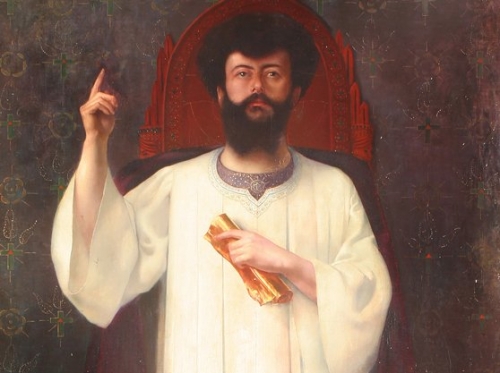
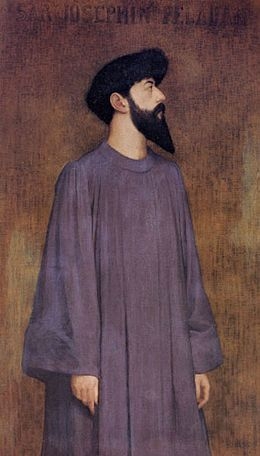 Péladan was the head of the Ordre Kabbalistique Rose-Croix (Kabbalistic Order of the Rosicrucian), succeeding his brother Adrien. While the original Rosicrucians, who had appeared mysteriously in Europe during the early seventeenth century and issued anonymous manifestos, seem to have been among the precursors of the Masonry and Illuminism that fermented the French Revolution against the Church and the Monarch, Péladan, on the contrary, was a Catholic traditionalist who repudiated the ideals of the French Revolution and the “Liberty, Equality, Fraternity” of the Grand Orient of Masonry, stating in 1883, “I believe in the Ideal, Tradition and Hierarchy.”
Péladan was the head of the Ordre Kabbalistique Rose-Croix (Kabbalistic Order of the Rosicrucian), succeeding his brother Adrien. While the original Rosicrucians, who had appeared mysteriously in Europe during the early seventeenth century and issued anonymous manifestos, seem to have been among the precursors of the Masonry and Illuminism that fermented the French Revolution against the Church and the Monarch, Péladan, on the contrary, was a Catholic traditionalist who repudiated the ideals of the French Revolution and the “Liberty, Equality, Fraternity” of the Grand Orient of Masonry, stating in 1883, “I believe in the Ideal, Tradition and Hierarchy.”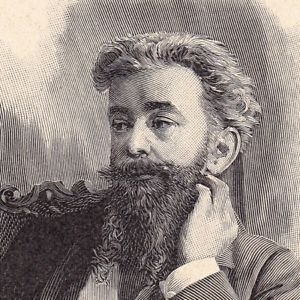 The Salon de la Rose et Croix was established in 1892 to exhibit Symbolist art to the public. Art was magic, not rituals and incantations. It was intended as the harbinger of a spiritual revolution that would overthrow the materialistic and the decadent, and as the antithesis to the art of the other salons. The first exhibition drew fifty thousand visitors. Clearly, the French yearned for something transcending the crassness of Grand Orient liberalism and secularism, which had rotted France for a century; the “disenchantment of the world,” as he called it. Richard Wagner’s music had a special place, Péladan regarding Wagner as “a therapeutic detoxifier of France’s materialism.” Erik Satie was the Order’s official composer, and Debussy was a close colleague. Péladan defined what was required in his appeal for exhibitors: “The order favors the Catholic Ideal and mysticism. After that, Legends, Myths, Allegory, Dreams, the paraphrasing of great poets, and finally, all lyricism.”
The Salon de la Rose et Croix was established in 1892 to exhibit Symbolist art to the public. Art was magic, not rituals and incantations. It was intended as the harbinger of a spiritual revolution that would overthrow the materialistic and the decadent, and as the antithesis to the art of the other salons. The first exhibition drew fifty thousand visitors. Clearly, the French yearned for something transcending the crassness of Grand Orient liberalism and secularism, which had rotted France for a century; the “disenchantment of the world,” as he called it. Richard Wagner’s music had a special place, Péladan regarding Wagner as “a therapeutic detoxifier of France’s materialism.” Erik Satie was the Order’s official composer, and Debussy was a close colleague. Péladan defined what was required in his appeal for exhibitors: “The order favors the Catholic Ideal and mysticism. After that, Legends, Myths, Allegory, Dreams, the paraphrasing of great poets, and finally, all lyricism.”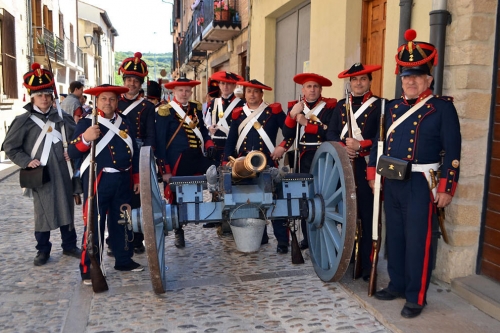
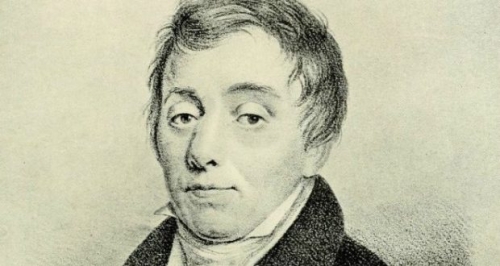
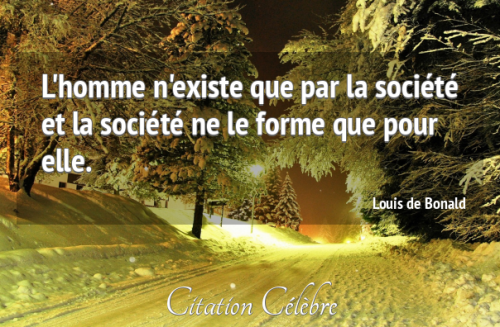
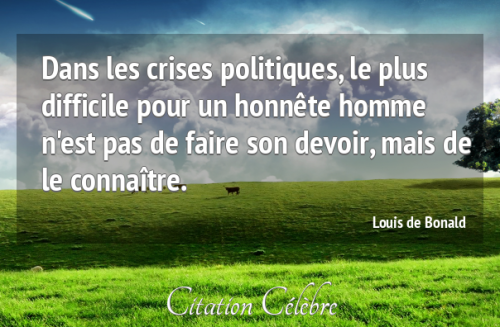
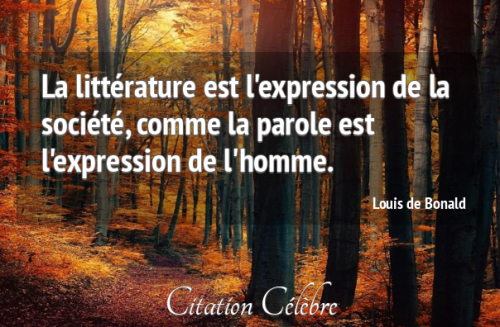

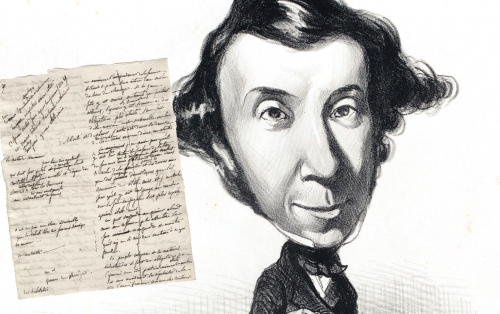
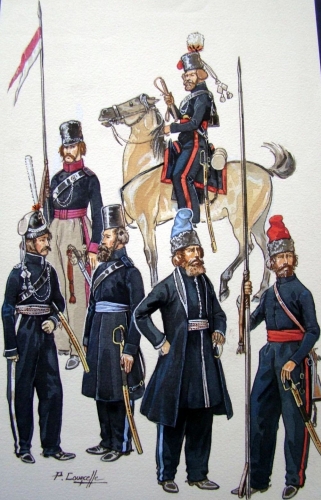 Tocqueville décrit cette préparation à la grande guerre européenne (et je crois que mon ami
Tocqueville décrit cette préparation à la grande guerre européenne (et je crois que mon ami 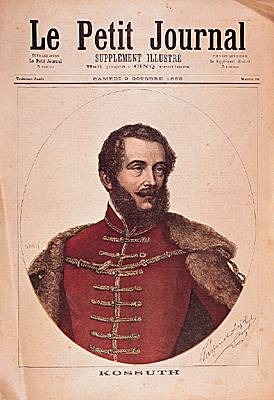 Puis Tocqueville met les pieds dans le plat sans mâcher ses mots cette fois :
Puis Tocqueville met les pieds dans le plat sans mâcher ses mots cette fois :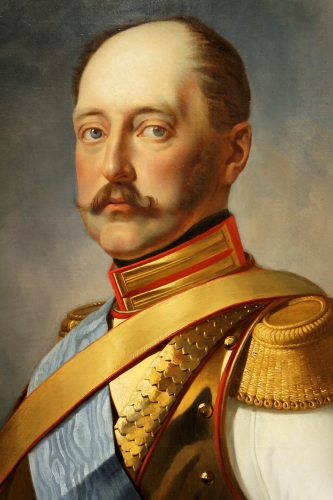 Comme notre Poutine, le tzar Nicolas garde son sang-froid :
Comme notre Poutine, le tzar Nicolas garde son sang-froid :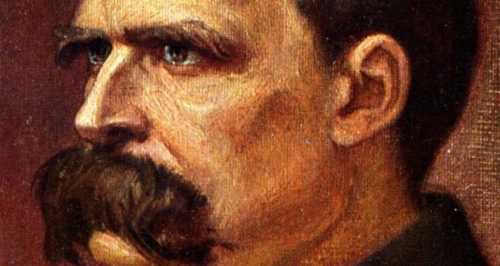
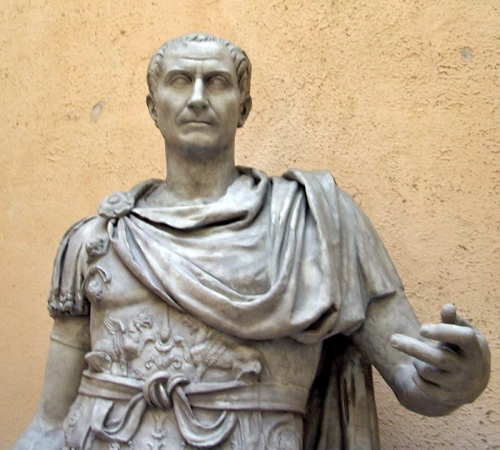
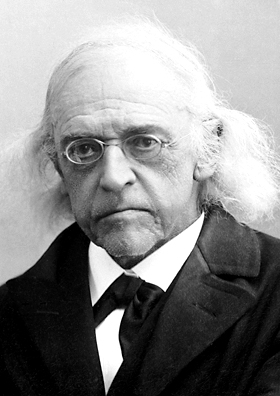 Was de geschiedenis van Rome een voorafspiegeling van die van het Duitsland waarin Theodor Mommsen leefde en stierf?
Was de geschiedenis van Rome een voorafspiegeling van die van het Duitsland waarin Theodor Mommsen leefde en stierf? 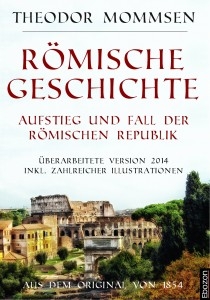 Zijn die harde woorden, die harde oordelen van Mommsen over Bismarck en het door hem verenigde Duitsland wel gerechtvaardigd?
Zijn die harde woorden, die harde oordelen van Mommsen over Bismarck en het door hem verenigde Duitsland wel gerechtvaardigd? 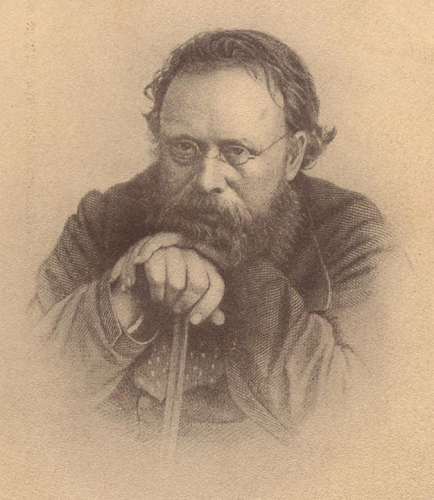
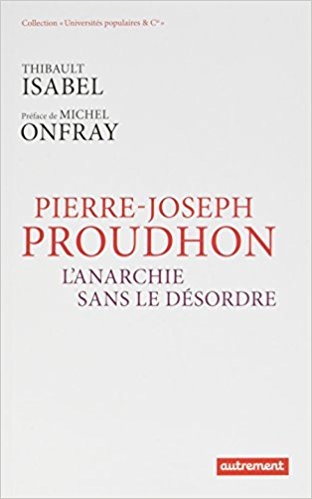
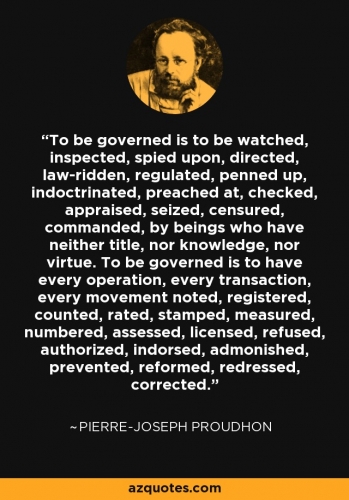
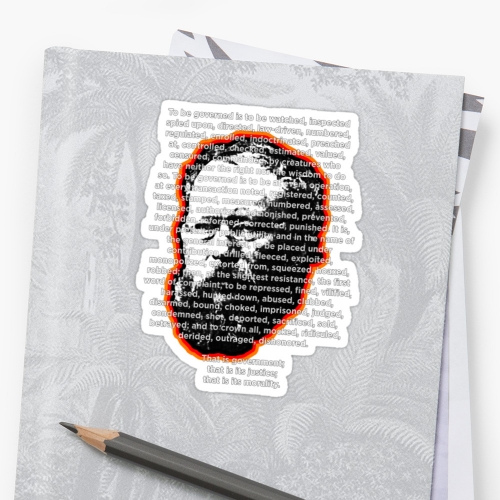
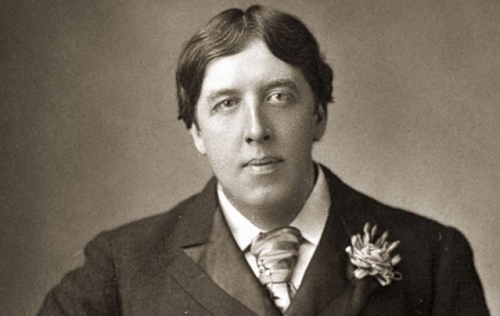
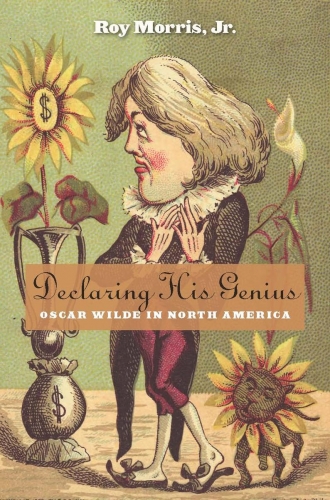
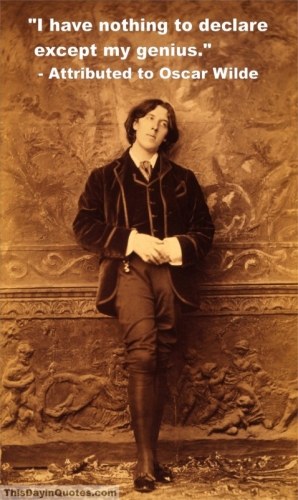
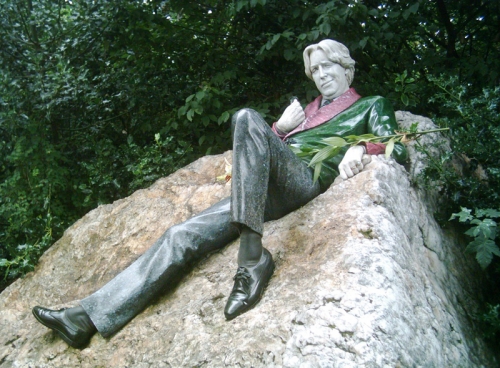
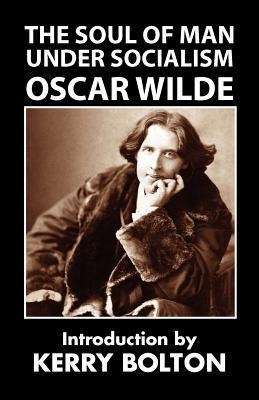
Neben diesen Riesen nimmt sich der spanische Beitrag zu der Sache „Liberalismus“ recht mickrig aus. Allein der Name geht auf spanische Geschehnisse „von vor zweihundert Jahren“ zurück.
Der Liberalismus brachte einen Jahrhundertbrand für Spanien
Seit dem 1812 – zur Zeit der napoleonischen Besetzung Spaniens – in der freien Hafenstadt Cádiz vollzogenem Verfassungsexperiment, standen die Anhänger des Absolutismus denen des Liberalismus feindlich gegenüber. Erstere wurden von den Verfechtern von Volkssouveränität und Parlamentarismus „Servile“ geschimpft, diese wiederum nannten jene abschätzig „Liberale“. Von Cádiz und aus dem Spanischen fanden „liberal“, „Liberaler“ und, endlich, „Liberalismus“ schnell Eingang in den modernen europäischen Wortschatz.
So schnell, wie die Liberalen die Chance ergriffen hatte, die ihnen die Kriegswirren – inklusive scheußlichsten Thronstreitigkeiten, an deren Ende die Gefangennahme der gesamten Königsfamilie durch Napoleon, stand – geboten hatten, genau so schnell formierte sich die absolutistische Opposition: Nicht wenige der 1812 nach Cádiz berufenen gewählten Abgeordneten waren geschworene Feinde des Liberalismus.
Mit dieser ihrer Bitte rannten die deswegen später von den Liberalen auch als „Perser“ verschrienen Absolutisten bei Ferdinand, der nur allzugern den Monarchen von Gottes Gnaden abgeben wollte, offene Türen ein. Trotzdem: mit dem Cádizer Verfassungsexperiment war ein Jahrhundertbrand gelegt. Für Spanien brach eine neue Zeit der Verfassungskämpfe und Bürgerkriege an, welche im Bürgerkrieg (1936-1939) ihren vorerst letzten Gipfelpunkt fand.
Ein gottesleugnerischer Humanismus
Im Zuge der Restauration des Ancien Régime, die in Spanien den Charakter einer regelrechten Rückgängigmachung von Französischer und liberaler Revolution annahm, kam es zu Liberalenverfolgungen solchen Ausmaßes, dass sich selbst das legitimistische Europa, mit Metternich an der Spitze, darüber entrüstete. Tatkräftig unterstützt wurde die Reaktion in Spanien vom Klerus.
Der Klerus hatte gute Gründe, den Liberalismus, der ein direkter Erbe von Aufklärung und Revolution war, zu verfolgen. Der aufrichtige Katholizismus vieler Liberaler änderte nämlich nichts daran, dass ausnahmslos jeder Liberalismus, sei es theoretisch, sei es praktisch, ein gottesleugnerischer Humanismus ist: „Menschenrechte“, „Philanthropie“, „Humanität“, „Volkssouveränität“, „Rationalismus“, „Selbstbestimmung des Individuums“, „Fortschritt“, verstanden als irdische Vervollkommnung und moralische Höherentwicklung des Menschengeschlecht, standen und stehen in einem unvereinbaren Gegensatz zu Gott, seiner Vorsehung sowie seiner Weltordnung.
Ihre Ideologie machte die Liberalen politisch gefährlich
Auch politisch war der Liberalismus bei weitem nicht so harmlos, wie es auf den ersten Blick, d.h. noch zu Cádiz, 1812, geschienen hatte: Von Anfang an sorgten für seine Verbreitung Geheimgesellschaften, allen voran die Freimaurerei. Es war geradezu eine Spezialität spanischer Liberaler und Freimaurer, überall Verschwörungen, wie z.B. die, welche 1820 im unteritalienischen Bruderkönigreich Neapel-Sizilien die Revolution auslöste, anzuzetteln.
Auch war es nicht unüblich, dass dieselben Verwaltungseliten des Absolutismus gleichzeitig ebenfalls Anhänger der liberalen Sache waren. So war es unvermeidlich, dass der letzte monarchische Absolutismus in Spanien über kurz oder lang den Liberalismus befördern würde, wenn auch unfreiwillig. Aus diesem Grunde auch scheinen alle späteren Tatsachen das liberale Selbstbewusstsein zu bestätigen, die von der Geschichte als „richtig“ vorgestellte Richtung, wenn nicht gar denselben Sinn der Geschichte, zu repräsentieren.
Der Liberalismus hatte für die Liberalen unzweifelhaft auf seiner Seite das geschichtliche „Recht des Neuen“ gegenüber dem Alten und Verbrauchten. In diesem Sinne das Neue und deshalb wirklich Rechtmäßige zu verkörpern, trieb die liberale Ideologie zur politischen Handlung an.
Die spanische Revolution von 1820 und die Heilige Allianz
Im bereits genannten Jahre 1820 gelang es den Liberalen, sich mit Hilfe des von ihnen unterwanderten Militärs für drei Jahre an der Macht zu halten. Während dieses sogenannten „liberalen Trienniums“ (Trienio Liberal) ging es hoch her in Spanien. Es kam zu den ersten antiklerikalen Gräueltaten – in Madrid war eine Gruppe Geistlicher auf offener Straße ermordet worden –, zu „Privatisierungen“ sowie zu unpopulären „kapitalistischen Reformen“.
Alarmiert von den Vorgängen in Spanien und Neapel beschloss die Heilige Allianz unter der Führung der Großmächte Russland, Österreich und Preußen, dem revolutionären Treiben in Südeuropa ein Ende zu setzen. Eine Intervention war so oder so unumgänglich. Namentlich die neapolitanischen Vorgänge hatten gezeigt, welche Kreise eine Revolution in Spanien ziehen konnte: Nicht ganz zufällig hatte die neapolitanische Verfassung die spanische von 1812 zum Vorbild und war auch sonst unter Mitwirkung bedeutender spanischer Liberaler zustande gekommen.
Nach der Intervention der Heiligen Allianz in Neapel-Sizilien wussten die spanischen Liberalen, dass sie als nächstes dran sein würden. Deshalb versuchten sie, sich auf ihre eigene doktrinäre und ideologische Weise in „Europa“ – worunter sie vornehmlich ihren imaginären Verbündeten Frankreich verstanden – Gehör zu verschaffen, was natürlich misslang.
Das real existierende Europa war restaurativ, das System der internationalen Politik das der Legitimität und des „Gleichgewichts der Kräfte“, nicht das der „Solidarität zwischen freien Völkern“ wie die spanischen Liberalen genauso trotzig wie verzweifelt verlautbaren ließen. Überhaupt machten Trotz und Verzweiflungsgeheul auf die Heilige Allianz nicht den geringsten Eindruck.
Auf dem Veroneser Kongress (1822) wurde Frankreich damit beauftragt, ein Expeditionsheer unter der Führung des Herzogs von Angouleme nach Spanien zu entsenden, um König Ferdinand als absoluten Herrscher wieder einzusetzen. Die Franzosen, die 1823 in Spanien eindrangen, um die Rechte des Thrones und des Altars wieder herzustellen, wurden als die „hunderttausend Söhne des heiligen Ludwig“ vom spanischen Volk als Befreier, und zwar vom Liberalismus, umjubelt.
Im Schatten des Absolutismus wuchs der Liberalismus
Mit dem unrühmlichen Ende des „Liberalen Trienniums” setzte eine extreme Reaktionsperiode ein (1823-1833), die von den Liberalen das „abscheuliche Jahrzehnt“ getauft wurde. Trotz der Schwere der Verfolgungen sowie zahlreicher Hinrichtungen konnten die Liberalen weiterhin an ihrer Revolution arbeiten: Als Untergrund standen sie in ständigem Kontakt mit ihren politischen Weggefährten im französischen und englischen Exil.
Auch die Solidarität unter Freimaurern leistete ihnen gute Dienste. Und dank der Änderung des internationalen politischen Klimas sowie der anhebenden kapitalistischen Entwicklung Europas konnten sie nun doch Unterstützung, und zwar von England und Frankreich, erwarten. Der ultraabsolutistischen „Kamarilla“ um Ferdinand – von daher stammt übrigens auch des deutsche Wort – zum Trotz war ab 1830 sogar der Hof liberal durchsetzt: Königin Marie Christine, selbst liberalen Reformen nicht abgeneigt, legte ihr gewichtiges Wort für liberalisierende, später offen liberale, Räte und Minister ein.
Es darf also nicht wundern, dass, als Ferdinand VII. 1833 starb, den Liberalen Spanien wie eine reife Frucht in die Hände fiel. Eine erneute Thronstreitigkeit – diesmal mit dem Bruder Ferdinands, Don Carlos, dem absolutistisch-legitimistischen Thronanwärter – bot den Liberalen einen Rechtsvorwand, sich der Krone zu bemächtigen: Angeblich im Sinne des traditionellen kastilischen Erbfolgerechts hielten die Liberalen die „Rechte“ der kaum den Windeln entschlüpften Tochter Ferdinands, Isabella, hoch.
(Bild: Verfassunggebende Versammlung, Cádiz 1812)